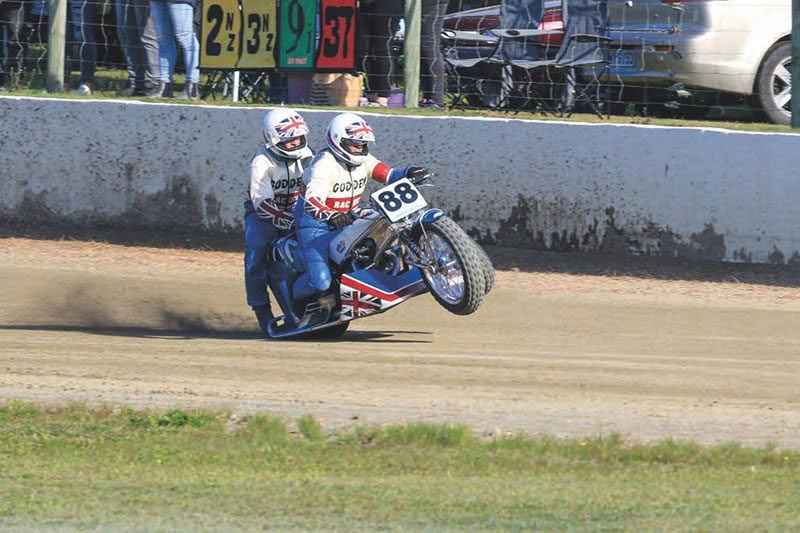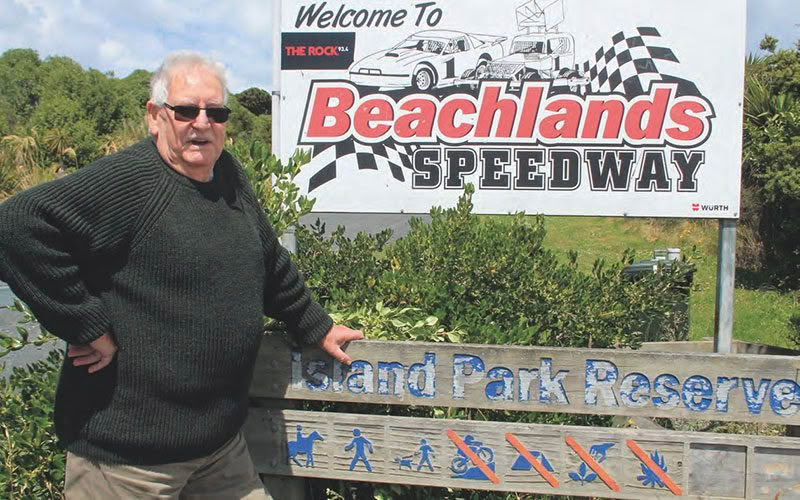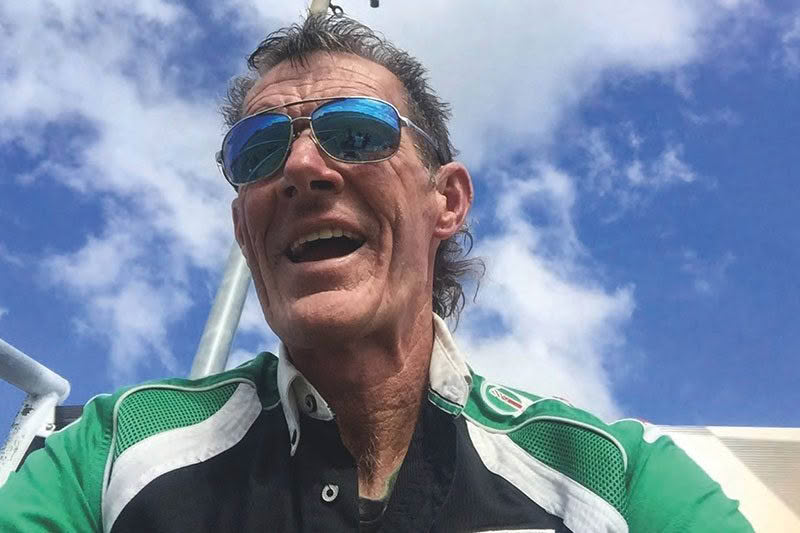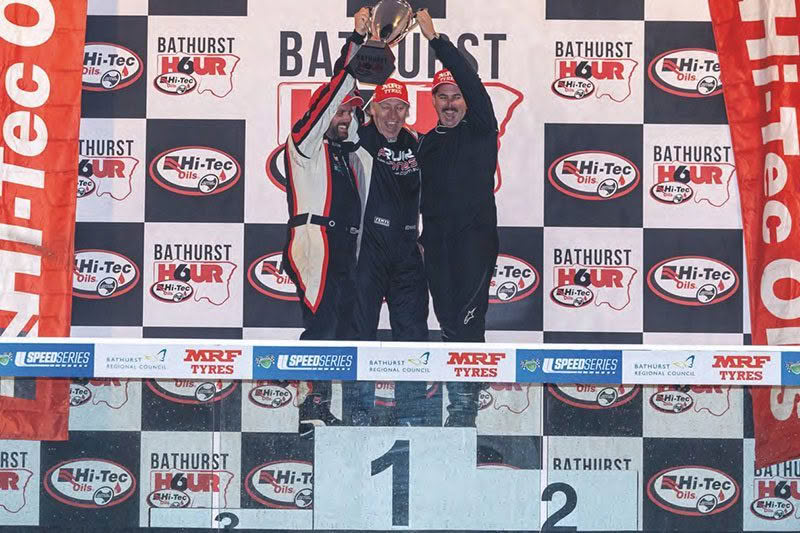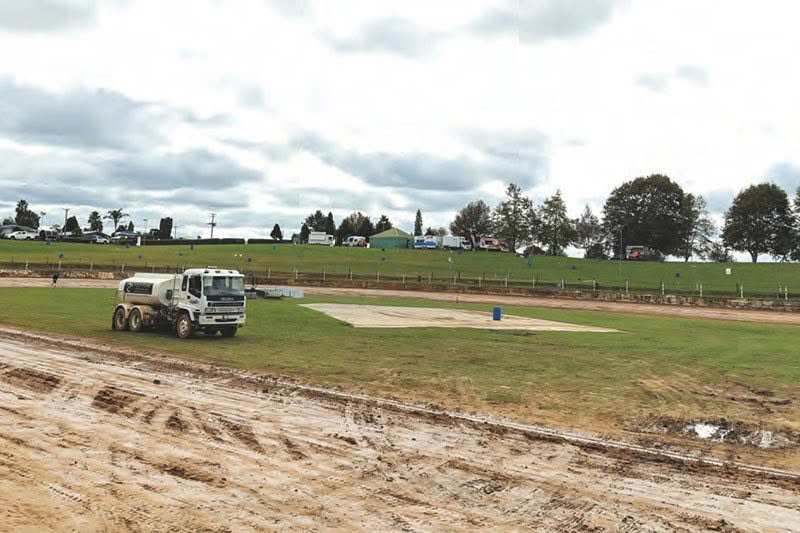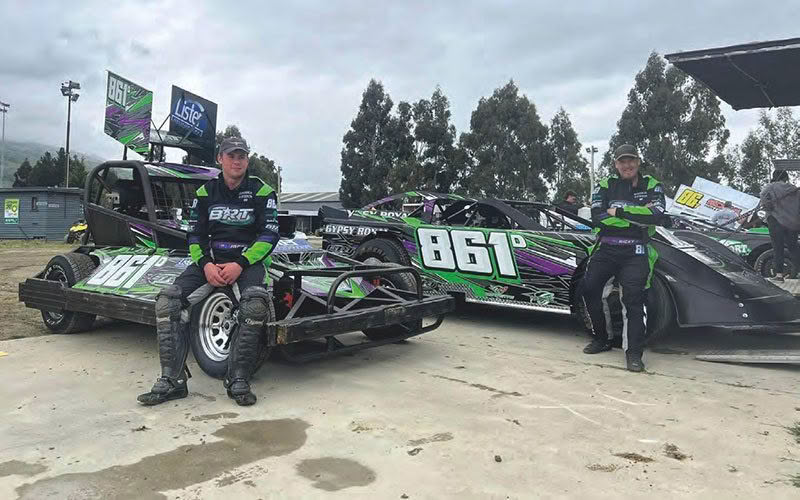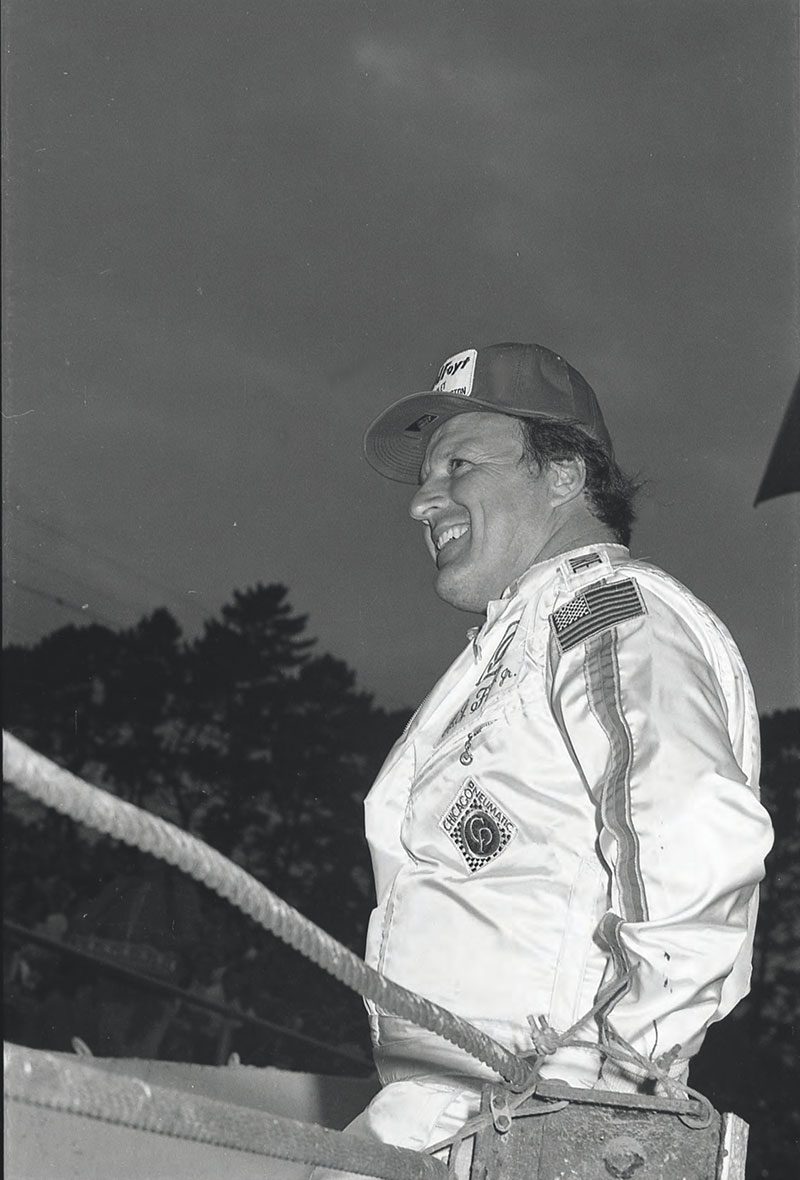Striking gold at Riverside
Another speedway season has come and gone at Aotea Electric Riverside Speedway, which hosted its final meet of the season in front of an eager crowd of patient fans.
Severe rainfall just hours before the meet soaked the track and delayed the start time, setting the scene for an eventful night of racing.
The fans relented, remaining to witness a number of season-ending title deciders as well as Saloon, Stockcar and Streetstock Memorials, the Sprintcar Southland Championship and Saloon Best Pairs.
Stockcars
An impressive 17 Stockcar contested the Ronnie Tree Memorial, the event rewarding the top three cars but, more importantly to many, the Stirrers trophy.
The cars were the first on track that night, making for a complicated watch with track conditions offering limited grip from the earlier rain.
Despite the wet track, there were just three stoppages in the opening heat, with Riverside drivers Zach Newsham, Kahu Moxham and Adam Naber all halting proceedings.
Beachlands driver Trazarn Ryland- Annabell would continue the strong form he showed on his home track a week earlier, taking the win over Central Motor Speedway’s Brian Taniwha and Riverside’s Shaun Hughes.
The track was drying nicely and had plenty on offer for the drivers once Heat 2 began, with Taniwha getting off to a flying start as the action unfolded behind. The crowd was instantly thrilled when Naber measured Hughes on the main straight, putting him well up the wall before continuing with his rival forced from the race.
Shannon Simon of Beachlands parked up on the back straight later on, causing another stoppage, while Moxham would again pull up in Turn 4 for the third caution. Unfortunately, Race 1 winner Ryland-Annabell failed to get going off that restart, bringing out another red light.
Taniwha would remain trouble-free as the drama unfolded behind, taking the win over Riverside’s Luke Fallow and his clubmate Peter Knight.
Confusion reigned in Heat 3, with Riverside’s Shanan Knight parking up and bringing out the red, heading infield but returning to the track shortly after to battle on.
Several drivers would have wished he’d remained out as he returned to the track to get in amongst everything, the performance seeing him awarded the Stirrers Trophy.
Hughes also came under fire in this race while parked on the back straight. The race was allowed to continue, but unfortunately for Hughes, he was hit hard while parked up by Riverside’s Jenna Tree and Central Motor Speedway’s Casey McEwan, who were in their own heated battle.
Out front again was Taniwha, who was doing it easy, remaining untouched to win heat three ahead of Ryland- Annabell in second and Newsham having his best day out in third place. This would give Taniwha the Ronnie Tree Memorial Trophy, with Tree second and Shanan Knight third.

Saloons
Eight entries were present in their final run of the season at Riverside, but the numbers didn’t matter due to the sheer class and competitive nature of those who showed up to compete for the Rod McLaren Memorial.
Riverside’s Dan Black got off to a flying start in Heat 1, pulling a gap to the field before a caution was called when fellow local Darren McLeod went into the back of clubmate Darcy Hewitt. McLeod backing off caused Mark Dobson to run into his rear, putting both cars out of action, while Hewitt managed to remain running.
Black would again pull away from the pack off the restart, building a lead that he would hold to the end to win ahead of Dunedin duo Ryan Bennett and Jason Gold.
Central Motor Speedway’s Phil Burgess got off to a solid start in Heat 2, with Gold and Riverside’s Graham Williamson both in hot pursuit. Gold and Williamson managed to make a move on Burgess, then went wheel-to-wheel for several laps.
Gold looked to have the race won, coming out of Turn 4 with the lead on the last lap, only for Williamson to charge up next to him on the dash to the line. Gold got to the flag first, the thrilling finish seeing the pair just .069 seconds apart. Burgess capitalised off his strong start to retain third.
The Rod McLaren Memorial and the Best Pairs Championship were both decided in Heat 3, the race again featuring a brilliant battle between Williamson and Gold.
Gold had the advantage of getting to Turn 1 first, but the pair had company as Hewitt joined the party in his most impressive race of the season. Hewitt didn’t look out of place challenging the leaders in the early laps but faded slightly as the race progressed.
A win over Williamson was the icing on the cake for Gold’s fantastic season, the Dunedin driver sitting his car beautifully mid-track, which made Williamson either have to go high to force a pass or wait for an unlikely mistake from the leader.
The victory gave Gold the Rod McLaren Memorial Trophy, with Williamson finishing second in both the race and Trophy battle. Hewitt’s third in Heat 3 wasn’t enough to stop Black from taking third place for the round.
Williamson did, however, get a chance to stand on the top step by taking out Best Pairs in partnership with Black, topping second-placed Gold and Bennett and third-placed Burgess and McLeod.
Streetstocks
Streetstocks were on hand to race for the Cecile Kergozou Memorial Trophy, and early crowd favourite Chris Kergozou would be out in Heat 1, his car dropping a cylinder, meaning the family trophy would elude him once again.
The opener had plenty of action, with the track still holding a fair bit of moisture, meaning cars didn’t need much of a hand to rotate around. A mid-race stoppage came when Riverside’s Stu Reid was sent from the track with a flat tyre. Riverside’s Lance Yeo would also be extracted at this point with bumper damage, and just a couple of laps later, it would be Steve Dryden of Riverside sent infield.
Beachlands drivers were just too good in Race 1, with Ben Jenkins taking the win ahead of Mitch Lavender with local driver Troy Dryden offering the crowd something to cheer for with third.
The second race saw a solid hit on Lavender from Riverside’s AJ Lapsley on the back straight, ultimately ending Lavender’s event. Steve Dryden was also looking menacing in this race, trying his best to unsettle the Dunedin drivers with nothing to lose after not finishing heat one.
Dryden’s attention would allow his son Troy Dryden to claim the race win over Dunedin’s Allan Finch and defending Champion Dillon MacHattie of Riverside.
The only stoppage in Heat 3 came with debris on the track. This was an entertaining race with plenty of hits but not resulting in stoppages. Steve Dryden would continuously wait for the leaders, but they were up to the task, avoiding damage and staying out of harm’s way.
MacHattie was strong out front and would claim the win, with Finch placing second and Jenkins third. These results resulted in a three-way tie for first place between Troy Dryden, Finch and Jenkins.
A four-lap runoff would be needed, and Jenkins wasted no time getting to the front and charging off. Finch snuck through to second, leaving Dryden at the rear. These positions would not change, giving Jenkins the Cecile Kergozou Memorial trophy.

Sprintcars
The final Southland Championship of the season to be run was for Sprintcars, and just a small field of cars were entered. Four vehicles from Central Motor Speedway and just the one Riverside entry would battle with defending champion Nigel Colvin of Cromwell on hand to defend his title.
Heat 1 saw Cromwell driver Shanarrah Stronach bolt off to a flying start, clear air helping build a lead that she would take to the finish line for the win. Colvin would need to settle for second, with Riverside’s Ross McKinnel third.
McKinnel would dish up some dominance of his own in Heat 2, showing the opposition that he wouldn’t be a pushover for his club’s championship. This heat would also see Colvin have a lively spin in Turn 2 but manage to keep the car going to rejoin the field.
McKinnel would take a famous race win in front of home fans while Stronach placed second ahead of Colvin, who worked his way back to third.
Points were tight with such a small field going into Heat 3; the championship was anyones for the taking. The key would be to get the best start lead into Turn 1, which Stronach, who started on the outside, managed to do.
Stronach got the nose in front and cleared off early, while McKinnel and Colvin went toe-to-toe for the first couple of laps. By the time Colvin had broken the shackles, Stronach had around a half-straight length lead that Colvin was starting to chew into.
Laps were fading quickly, and Colvin’s run had been left too late, with Stronach snatching her second race win of the day and her maiden Southland Championship. Colvin would place second in this race and overall, while McKinnel would cap off a solid day, third in race three and third overall.
Production Saloons
Riverside’s Tony Jones came from well down the pack to claim a well-driven win in Heat 1 of the Production Saloons, topping club-mate Dave McKenzie who led most of the race. It was a Riverside top three, with Fitzgerald third.
Race 2 was more of the same, but easier this time for Jones from a front-row start which set the way for another dominant race win. Fitzgerald moved up a spot from Race 1, claiming second, while Central Motor Speedway’s Liam Ballantyne continued his strong form for third.
Youth Saloons
Youth Saloons saw a big field, and it looked like Cayden Race of Riverside was going to be the runaway winner. A brilliant drive from club-mate Josh McIntyre would see him hunt down the leader, passing him with a couple of laps to run to take the win. Race would secure second, with Beachlands’ Noah Kitto home in third.
There was a great battle over the early laps of Race 2 between McIntyre and Riverside’s Joshua Richardson, the pair clearing off from the field and putting on a great battle until McIntyre negotiated lapped traffic a little better to catch a break. McIntyre would win his second race of the day from there, leaving Richardson to settle for second over Kitto, who was again third.
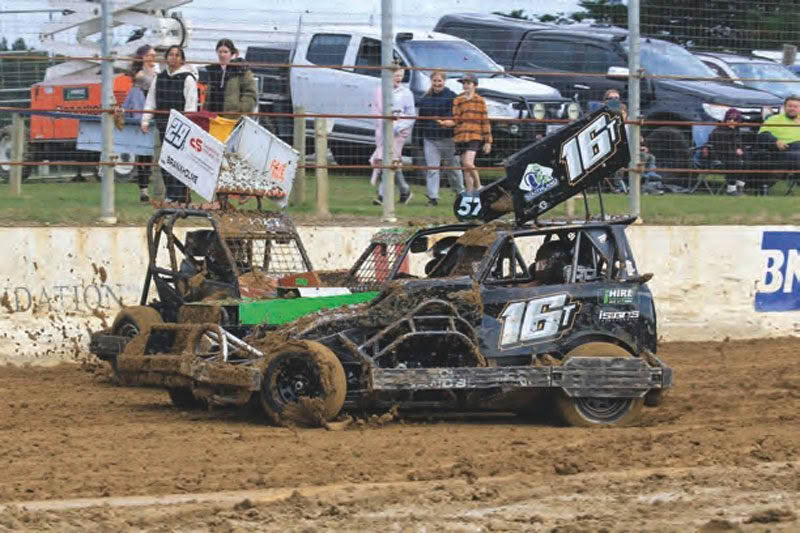
Six Shooters
Six Shooters were the heroes of the event, with the grade doing a massive amount of wheel packing early in the day, followed by the Saloons, trying to produce a raceable surface.
Six Shooters featured Southern Sprintcar Series winner Adam Evans of Central Motor Speedway, who jumped back in his car to have a run.
Evans would work away at the front of the pack and battle hard with Riverside’s Duane Cracknell for the front spot. Evans would build a lead as the race went on, taking advantage of a track starting to take great shape under him. He would take the race win from Cracknell, with Ruapuna driver Kirk Hawkins placing third.
The final race for Six Shooters saw Riverside’s Hayden Graves come unstuck in Turn 4, with Cracknell making contact with the spinning car but able to continue.
Up front, it was again Evans who was all class, this time heading off the challenges of Riverside’s Harrison Brown and Daniel Livingstone. These placings are how the race would finish, giving Evans the perfect day out.
Demolition Derby
The Demolition Derby was run with just fourteen cars, showcasing the difficulties with sourcing cars with numbers previously having averaged 70 competitors in years gone by. Josh Chirnside was the last car running in the derby to take the win.
Bikes thrill at Oreti Park Season-Ender
A rescheduled season finish at Southern Bolts & Fasteners Oreti Park Speedway saw the Southland club as the last of the lower South Island Tracks to run a meeting this season; a balmy autumns day is greeting competitors and fans alike.
While only a few spectators were on hand when the meeting kicked off on Saturday morning, numbers grew to a pleasing turnout by the end of Round 1 of racing. All those in attendance were certainly treated to some great racing across all the classes, particularly the Northside Sand and Gravel Southland Classic Sidecar Championship.
Heading into the event, it was a lottery with just four local Oreti combinations entered. The most experienced pair were Gary Wells and Jamie Harpur, a dominant force in the eighties at the venue. They would battle it out against combinations who are still riding at a competitive level now, including the current 2NZ pairing of Paul Humphrey and Chris Chatfield.
Heat 1 would give some form guide as to who was going to be the movers and shakers in this championship, and it took no time for the experience of Wells and Harpur to show as the pair powered into Turn 1 ahead of the pack to remain unchallenged for the rest of the race.
There was a solid fight for the minor placings going on behind, and Humphrey and Chatfield would get home for second ahead of Jase Kennedy and Jonny Casey.
The second heat was a much closer battle up front, with Humphrey and Chatfield leading early before being tactically taken down the inside by Wells and Harpur. Humphrey would try and stick with the new leader, but Wells and Harpur negotiated the corners with expertise, looking smooth and fast to take their second race win. Humphrey and Chatfield held firm for second, while Bradley Sharp and Erwin Tree would steal third.
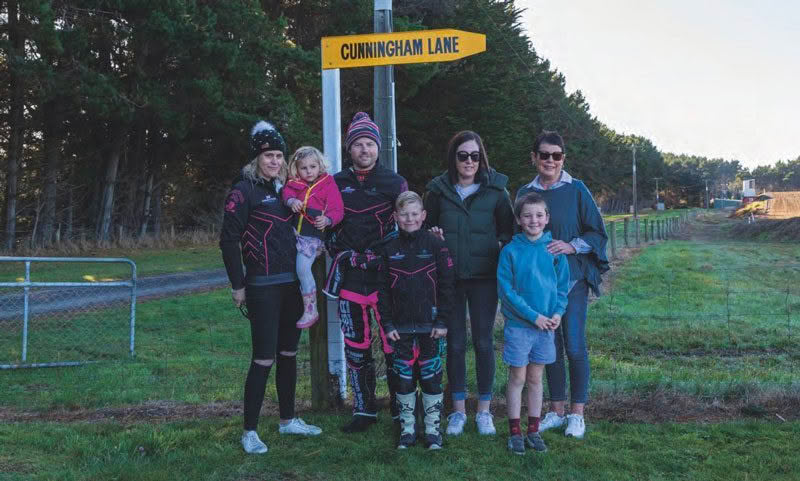
You would be brave to bet against Wells and Harpur going three from three come Heat 3, and to be fair, despite the margins closing, these guys were still hitting their straps. They put in yet another dominant performance to all but seal the title. Sharp and Tree impressed to finish second, ahead of Humphrey and Chatfield third.
The deciding heat for the Southland Classic Sidecar Championship produced the best battle of the day, with both Humphrey and Sharp getting into Turn 1 ahead of Wells, who looked to bog down somewhat off the start line.
Wells would give chase and make a move on Sharp and Kennedy to slip into second and start to give chase on Humprey. This race was certainly one for the ages as neither combination would give an inch, Humprey and Chatfield looking as if they would cause the upset of the day. Wells and Harpur, however, worked their magic and flew down the outside on the back straight to steal the lead away, a lead that would not be challenged.
Wells and Harpur took the race win and the Southland Championship ahead of Humphrey and Chatfield, who were forced to settle for second in the race and championship.
Kennedy and Casey would get third in this race, but third overall would go the way of Sharp and Tree.
Pee Wees would kick off the day’s entertainment, and no one would get anywhere near Oreti rider Carey Sharp who was dominant in all four heats. Sharp got solid starts in all heats and powered off on the small track to remain unbeaten all day.
The battle for second and third was much more evenly matched, with two up-and-coming Oreti Park riders exchanging results across the day. Heat 1 saw Eva Chapman grab second ahead of Max Cracknell, while those positions reversed in Heat 2. Cracknell also claimed second in Heat 3 when Chapman stalled her bike on the line, but she bounced back to claim second ahead of Cracknell in the final run.
The overall results in Pee Wee were Sharp first ahead of Cracknell, with Chapman third.
A strong field of 125cc Solos were on hand and produced some of the day’s best racing. Heat one saw Oreti Park’s Slade Fordyce take the race win in Heat 1 ahead of clubmate Jack Chapman and Moore Park’s Cooper Lang.
The second race of bikes was dominated by Oreti’s Mauger Kelman, who was all class and used every inch of track available to him to grab early points. Second was club-mate Ollie Cunningham, with Jack Campbell third.
The third heat for 125cc Solos saw Cunningham race off to a fast start and never appear challenged, heading home for a comfortable race win. Second was Fordyce, with Lang home in third.
Kelman was a cut above his competition once again in Heat 4, pulling to an early lead and again taking the checkered flag with ease. Behind him, Chapman’s race would, unfortunately, slip away with a mechanical drama on the last lap, allowing Oreti’s George Kennedy to snatch second.
Kennedy turned on the gas in Heat 5, taking a well-deserved win. The win looked to be going the way of Fordyce but leaving a gap on the last lap allowed Kennedy to swoop through and take the win. Fordyce held second, finishing just ahead of Chapman.
Kelman again would come out hot in Heat 6 and tear apart his rivals, the young local rider showing off his skills to claim his third win in as many starts. Cunningham finished second, with Lang third.
Kelman was again smooth and fast to piece together a perfect day out to bag his fourth race win of the day in Heat 7. Second place went the way of Fordyce, with Kennedy third.
The final race of the day in the 125cc Solos was taken out by Cunningham ahead of Lang, with Chapman third.
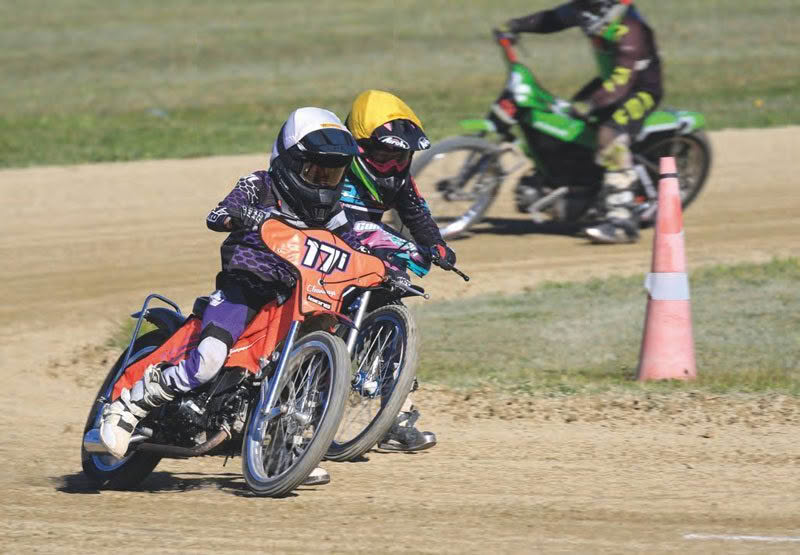
This gave Kelman the overall win for the day over Cunningham, with Fordyce would take third overall. Next up on the junior track were the 200cc machines who would battle it out over five heats.
Race 1 saw Oreti Park rider Kadin Cracknell take an early win in what was a top ride against strong competition. Second place went the way of Moore Park’s Chase Lang, while local Jack Campbell was third.
Lang would go one better in Heat 2, taking a solid win after getting away from the tape smartly. Campbell would also move up the order with a strong second, leaving Cracknell to settle for third. It was a repeat in the order of placings in Heat 3, with Lang starting to stamp his authority on the field.
An upset was on the cards in Heat 4 when Campbell would ride his best ride of the event, upstaging both previous winners to take the flag, leaving Lang to settle for second ahead of Cracknell.
The final race for 200cc Solos again saw the finishing order shuffled around, Lang finding himself back in the front of the pack, with Cracknell delivering a solid second placing over Campbell.
Overall results went the way of Lang, with Campbell second with Cracknell third.
Sidecars combination Humphrey and Chatfield were hot favourites heading into the event, the current 2NZ team being the benchmark of the grade all season.
They were upstaged in an epic fight with Oreti Park combination Shaun Kerr and Harley Biddle in Heat 1, the winners looking extremely fast considering they are a new combination. They’d hold Humphrey and Chatfield to take the win, leaving the 2NZ second and Jason Harpur and James Dawson in third.
The second heat saw the local riders upstaged by Moore Park duo Ben Morris and Graham Partridge, the pair getting off to a flying start and beating the pack into Turn 1. They rode away from the field with ease to take the race win over Heenan and McDonald and Oreti’s Scott Ayto and Ramon Nikora Balloch.
Kerr would show that his first-up win was no fluke at all in Heat 3; he and Biddle again upstaging Humphrey and Chatfield to take their second win of the event. Humphrey would place second, while Gary Stalker and William Little of Moore Park were third.
Late race controversy was on the cards in Heat 4, where Harpur and Dawson comfortably led over Morris and Partridge. Behind them, Ayto and clubmates Dallas Kelman and Brent Nicholson came into contact, Kelman being deemed at fault. This handed third to Ayto and Nikora Balloch, while Harpur and Dawson held firm for the win over Morris and Partridge.
It looked as if Humphrey and Chatfield would finally get back to the top spot in Heat 5, leading Kerr and Biddle by a handy margin for the majority of the race. The checkered flag was out, and Humphrey powered out of Turn 4 on the way to take the win, only to stop mid-track with mechanical issues which put them out of the race just meters from the line. Kerr and Biddle peeled past for another win, with second going to Morris and Partridge over Kelman and Nicholson in third.
Harpur and Dawson were again in sublime form in Heat 6, getting away from the tapes fast and powering off for another well-deserved win. Behind them in second was Ayto and Nikora Balloch, while third went to Stalker and Little.
Humphrey and Chatfield finally got a clean break to take the lead into Turn 1 in Heat 7, despite a strong challenge from Harpur and Dawson. They would hold firm for a hard-fought win. Harpur rode well all day, and he and Dawson would place second over Morris and Partridge in third.
The final Sidecar race was another quality battle and caused the upset of the day. If you were a betting man, you would have put the house on Kerr and Biddle, but the pairing struggled off the line. Despite putting in one hell of a chase, Heenan and McDonald would snatch a famous win, with Kelman and Nicholson pressing them hard for second, leaving Kerr and Biddle to settle for third.
This result still gave Kerr and Biddle the overall win for the event, ahead of Harpur and Dawson, and Morris and Partridge.
There was an early upset in Solos when Oreti Park rider Dakota Crengle stole the show on a borrowed bike, racing clear to a solid start and pulling away to claim Heat 1 victory on a surface that was testing for the grade early on. Second went to Crengle’s clubmate Finn Reed, with Alex Cunningham placing third.
The current 3NZ, Reed, and Crengle were locked in a tight fight on the opening lap of Heat 2. Crengle would, unfortunately, drop his bike in Turn 3 of Lap 1 but would get back on and try and charge back through the field.
Reed was storming home fast out front and had the race win in the bag as Crengle raced back through. On the last lap, Crengle’s bike high-sided in Turn 1, sending him into the safety fence hard and leaving the young rider injured on the track. Crengle would return to his feet after being checked out and walk from the incident but not return again.
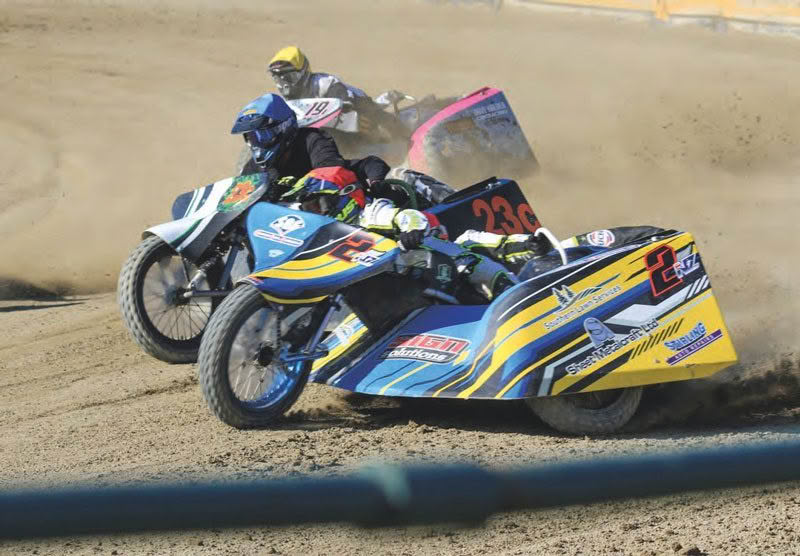
The win would go the way of Reed, with Lucas Colvin second over brother Ryan Colvin.
The track team went to work on the track surface for some time after this incident, producing a far safer racing surface for the meeting to resume.
Reed stole the show again in Heat 3, taking the win by almost half a lap over second-placed Ryan Colvin, who, this time, upstaged his brother Lucas in third.
Reed did it easy again in Heat 4, the youngster showing why he currently holds the 3NZ and that he’ll be a force in the Solo class for some time to come; his speed and skills are an absolute joy to take in. He would win over Ryan Colvin and Cunningham.
These results would be replicated in Race 5, giving Reed a comfortable win overall for the event, with Ryan Colvin finishing second overall and Lucas Colvin third.
The final grade to run was the Classic Solos, and Oreti Park rider John Tuffley was simply untouchable across all five heats. Tuffley would have looked competitive in the A Grade Solos with the dominance shown, leaving the real battles for second and third.
Oreti Park duo Les Payne and Allan Crosbie battled for the minors in Race 1, with Payne grabbing second ahead of Crosbie. These results would be the same in Race 2, but Crosbie would turn the tables in Race 3 to come home in second.
Payne wouldn’t be upstaged again, however, and would take second over his rival in the final two races of the event.
These results saw Tuffley take the overall win, with Payne earning second over Crosbie.
This meeting was also the unveiling of Cunningham Lane, the entry road to the pits, named in honour of the late Russell Cunningham, who had been an integral part of Oreti Park Speedways’ history as a competitor, sponsor and official for a number of seasons.
This was a fitting way to cap off another successful season of action at Southern Bolts and Fasteners Oreti Park Speedway.
Brian Illingworth: 52 seasons on the mic
How many people can say that at age 80, they have had a go in solos and raced an ex-Peter Woods Saloon car, all while continuing to run their own business in addition to working as a tutor at the local polytechnic?
That can only be one man: Brian Illingworth.
For Brian, the speedway bug bit deep and hard and he’s been hooked since his first involvement.
Like many, his first taste of the sport was a run on a solo. The young, fearless man straddled the bike as his hand opened the throttle, and away he went, going into a corner with a wooden fence fast approaching. As his eyes grew bigger than saucers, down the big fella went, the idea of competing as a solo rider going down with him.
After the unsuccessful venture on solo bikes, an opportunity for a go in a Vauxhall 16 at Halfway Bush was presented, which Illingworth tells me ended in the ditch. It wasn’t a great start to the speedway world.

The next opportunity would come in the way of a borrowed 36 Ford V8 Coupe that belonged to Ron Griffiths. That venture brought some long-awaited success and joy.
While continuing with his racing, Illingworth was given exposure to the microphone at Brownville in Mosgiel for the first time. That developed into something more frequent, where he would take turns commentating with Keith Simon, all while continuing to race whenever he could.
A move to Beachlands followed, where Illingworth first campaigned a 54 Customline. When that was destroyed, a decision was made to purchase the ex-Peter Woods’ Morris Minor, fitted with a 1500cc Cortina motor.
From the grin on his face, I could tell it was a lot of fun.
Brian would move on to commentating and, for 52 seasons, has been the voice behind the mic’ at Beachlands. He’s had many different roles at that Speedway, having raced and served on the committee, becoming a life member long ago.
Illingworth has not only applied his expertise at Beachlands, taking his silky skills to the likes of Cromwell, Riverside and Woodford Glen as well as doing the Road Race around Dunedin and National Grass Karts.
He remains a fan when not behind the mic at Beachlands, attending New Zealand Super Saloon Championships whenever possible and visiting most of New Zealand’s tracks along the way.
Illingworth says Peter Woods would be the best he has seen, recognising that he was a complete natural behind the wheel and made it look so easy. Another he would put in this mould would be Blondie Chamberlain, recognising his tenacity and lethal skills on track.
He says his favourite meeting would be the 1984/85 New Zealand Saloon Car Champs, the first time Dunedin hosted the event. This gave the locals a chance to see the best of the best, including the likes of Woods and Chamberlain. Outside of Beachlands, he says his next favourite meeting was Cromwell’s first big dance with Super Saloons.

The information he could give made Brian so good over 52 years, from things like chassis and engine size. He could quickly calculate the unofficial points if it were a Champs meet, importantly keeping the crowd informed.
Some of his sayings over the years were hilarious, with some favourites being “It’s got more pull than a schoolboy,” “It’s got more snot than a kid with a cold,” and “It’s melted its chocolates” These types of quotes stick in your head for years to come.
Although Brian is now primarily a spectator, he still does the odd meeting on the mic, and his love for the sport remains.
He has made many lifelong friends along the way and has been lucky enough to see some of the greatest drivers take to the clay quarter miles around New Zealand.
Thank you for your brilliant service to this great sport.
The thrill of the dirt
For the last few years, it’s been a Changing of the Guard, for me, so to speak, from the tarmac to the clay.
From a very early age, I have always loved speed and here in Timaru, we were lucky enough to have a circuit close by, where I was a frequent spectator, to watch and listen to the good ole V8s roar around the track.
I Flag Marshalled for the first time one year when I was 15 years old, which got me very close to the action, right there in the thick of it, on the edge of the track. That was the only time I did that for reasons which are about to reveal themselves.
As we all know, Motorsport is dangerous, and that’s part of the thrill of the adrenaline rush of speed with close racing, and even though I was only marshalling, I was hit for a six by an out-of-control V8 travelling at 160km/h after a tyre blow out.
I sustained a number of injuries, including loss of memory for a couple of weeks after falling from the sky and coming down headfirst into the ground. Once I healed, back to the track I went, this time content as a spectator.

It wasn’t the accident that put me off marshalling; it was the boredom of standing in one spot and not being able to get around and see racing from many angles.
As well as becoming a frequent spectator to many circuits in New Zealand, I also toured Australia for several years. I was lucky enough to get to many of the V8 racing circuits, from Queensland to Melbourne and the most iconic place of all, Mount Panorama, Bathurst, with 14 visits.
That place will always be firmly implanted in my veins and, as many have seen, firmly planted in my skin by “The Brocky Tribute” tattoo, which covers my entire back.
Returning to my hometown, Timaru, a few years ago, something was changing in how I got my ‘fix’ with motor racing. The good ole circuit racing had lost something; it wasn’t the racing that I remember back in the day, as it seemed to me to be much following each other around.
I found myself spending a lot more time on the road to the likes of Christchurch’s Woodford Glen Speedway, and by crikey, this was the changing of the guard. As the old saying said, “Tarmac is for getting there, Clay is for racing”, and this was it; Speedway was back in my sight after many years of not attending. Over the last five or so years, I have spent many Saturdays at Speedway venues, and this is by far the ultimate in motor racing.
One thing with Speedway, which is fantastic for the likes of a spectator, is that the whole racing circuit can be seen in such a short distance from one viewpoint, and the racing that comes out of those Pit gates always has action, no matter what the class.
What feeds my addiction to the ‘Need for Speed’ is the good old sound of a V8; there’s nothing quite like an “8 Pot Symphony” cranking around such a small circuit, with balls to the wall racing. The two that really grab me are the Modifieds and the Sprintcars, which, in my view, are the best racing there is.
Both classes carry massive tyres and foils on the front with huge roof fins on top, and the horsepower beneath is the good ole V8. Modifieds run a smaller cubic inch and carry more weight, but the Grandaddy of Speedway are the Sprintcars, which can produce up and around 900HP.
On a light body, these really are the ultimate of the speedway, with entry speeds of 160+ km/h cranking into a corner and exiting just as fast, with a large group in most races, there is nothing as exciting as seeing Sprintcars in action, nothing.
The great thing also, we all cheer on the first, second and third as they fill the top 3 on the Podium, but back in the pack, there are some wicked great battles and when you get high speed on such a small area, where all are chasing that black and white chequered flag. Controlled or uncontrolled, it can become mayhem in the blink of an eye; It’s hell on wheels in spectacular fashion.
As many may have seen via my videos, I spend most of my spare time at Speedway, with a camera firmly planted in my hand, in which I try to capture it and get close to the action. Still, one thing a camera cannot do, which gives you the absolute adrenaline hit of the atmosphere, is the full-blown sound and the huge rush of wind as these winged warriors power on past you at a colossal pace.
I’m certainly in no hurry to get back to circuit racing, I really do believe I have fully retired from circuit racing, but I know one thing, I can’t wait for the 2023/24 season of Speedway.
Another fantastic thing you see at Speedway is the terrific folk who run the event and a great number of spectators who line the caged arena there for the same reason as most, to see and have an exciting night of racing.
For those that have never been to Speedway, my advice is “Get Your Backside Trackside” because, throughout New Zealand, we have plenty of speedway action, awesome people, great classes of cars and a great night of full-on entertainment.
Early curtain call on Kihikihi season
The McDonald’s Kihikihi Speedway’s April 29 fixture was initially planned to be their closing night until a dire run of washouts saw the season extended to the following week. Rain that night also saw the meet washed out, save for the demolition derby, meaning the April 29 meeting did indeed round out the season.
Four feature attractions made for a solid night of action, with the King Country Stockcars and Rosetown Stockcar 25 lapper, Rosetown Midget 30 lapper and Saloon Battle of the Sexes making for some great racing.
While this was quite a solid bill, it traditionally wouldn’t get the punters in big numbers at the end of the year when public interest in Speedway is on the down. But, to the crowd’s credit, there was still a reasonable turnout.
The early 3 pm kick-off was a good call on an overcast day which saw a family-friendly finish shortly after 7 pm. It also meant the queues for coffee and food were short for a change.
The Waikato Placemakers King Country Stockcars is usually a well-supported event with plenty of out-of-town cars present. Unfortunately, the dire run of weather all venues have suffered from this summer meant that it clashed with Memorial events at Baypark and Huntly, plus the Stratford teams event.
This, plus quite a few local runners opting to garage their cars for the winter after the NZGP, meant that a relatively modest but still healthy field of 24 cars were trackside. With few heavy hitters in the field, the action could have been more extensive, the main point of interest being the battle for honours between local Dion Henderson and 2NZ Scott Tennant.
In the end, it came to a run-off which presented a fair bit more drama than the three heats proceeding it. Henderson won the run-off, becoming just the second local to win the King Country Championship since it was inaugurated in the 1997/98 season. Third was Rotorua’s Sean Wepa.

The Rosetown Stockcar 25 lapper, back after not being run last season with the heavy disruption caused by Covid, was an entertaining affair, with some big hits and heavy attrition that comes with a long race, making for a reasonably good way to finish the year. This was a reverse grid affair, with the highest points scorers from the King Country title starting from the rear. Henderson, in training for his Kings Superstock debut at Huntly the following week, went into block mode, impressively stopping any visitor, especially defending champion Wepa, from any chance of winning.
Ryan Marshall led for many laps only to get spun around, allowing fellow local Chris Shingleton to grab the lead and take the win. Marshall was right behind in second and was able to catch back up to Shingleton, but admirably played fair towards a fellow local and didn’t punt him off the track when unable to make a clean pass. Caleb Hayes made it a Kihikihi trifecta by coming home third.
Also back after a year of Covid- inflicted absence was the Saloon Battle of the Sexes, which this year was expanded into a two-round series with a Palmerston North leg in March.
There was excellent racing in all three heats, and as the ladies found some great form, Ashleigh Halcrow taking two wins and Angela Wintle the other.
It was the men who won the war by a wafer-thin one-point margin of 158-157, even after a minor setback when veteran Nigel Ross had a violent rollover in the elderly Monza he drove with great verve in the 90s up to the early 2010s, which is still competitive today against more modern equipment.
The Farmline/Giltrap Rosetown Midget 30 lapper suffered a little numbers-wise, with Western Springs also running at Waikaraka that night. The dozen on tap still put on a good show, with Hayden Guptill and local Mitch Fabish winning the heat races.
Baypark’s Shayden Austin, impressive in the heats with a few slide jobs, established a big lead in the feature after a super joust with early leader Fabish in the opening laps. Guptill, who started mid-grid after a Heat 2 DNF, was also flying to quickly sit second, unable to get on terms with Fabish until the Te Awamutu flyer had to retire with 11 laps to go when his car slowed to a stop.
The yellow to remove Fabish’s cars allowed Guptill to hit the front. However, Austin was not about to give way, keeping in pursuit to make a do-or-die slider on the final corner. Guptill was just able to sneak in for the win, but Austin was an absolute star of the race, showcasing that with his maturity and confident sliders, suggesting he is one to watch in the future.
Taking advantage of a high attrition rate was Greg Jones of Stratford, who rounded out the podium, and locals Leyton Kendall and the unique Brent Curran rotary were the only others to greet the chequered flag.
Five Super Saloons and three Saloons came along for the ride and provided great support to the features. Damian Orr ran partner Caitlin Hayward’s car to great effect to take a trio of wins. Saloons 3NZ Trent Amrein had a taste of big horsepower for the first time as he ran the Steve Cowling car, looking right at home from the get-go.
Local Mike Wilson showed some welcome reliability and fair pace, while Craig Marsh in the Mustang saloon was right up with them in the first two heats, embarrassing the more expensive cars in the process.
There was also good racing from the 20 Youth Ministocks, with Rotorua’s Cohen Wright in a class of his own and winning all three races.
The Classic Stockcars were a welcome addition with three exhibition races, and the sight of the Gary Parkes car that won the 1991 NZ Championship was a highlight for the writer. The car is from an era not that long ago in the overall scheme of things, so it’s sobering to reflect that a top-flight championship-winning vehicle from that era looks like a museum piece relative to today’s cars.
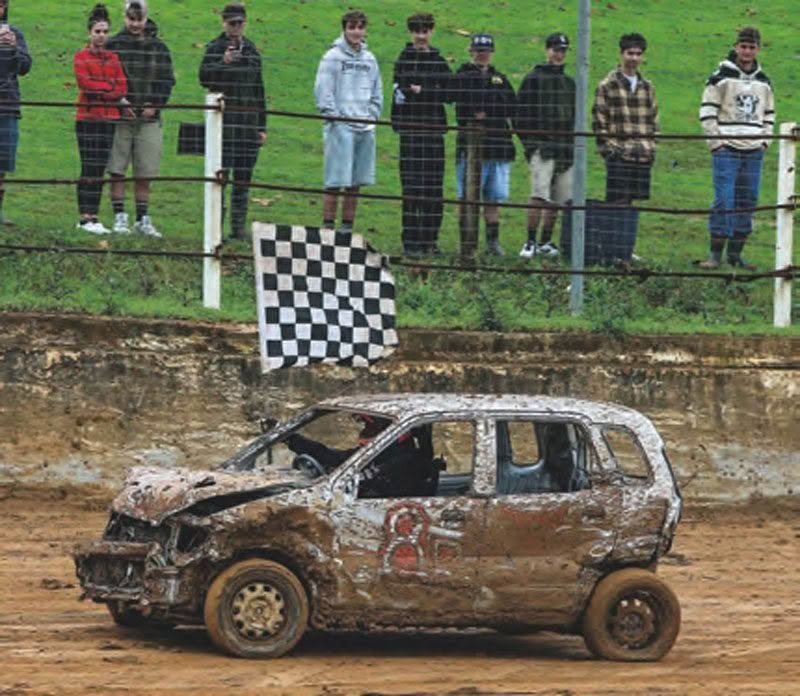
Driving home following the meet, there was the sense that Kihikihi was lucky to avoid the weather, with roads damp in places. This was a harbinger of what was to come as the forecast for the following weekend looked dire. It seemed that everyone mentally had already written off any chance of the final meeting a week later running.
A week later, the weather, despite heavy rain over the days prior, wasn’t as bad as predicted. There was no wind or sunshine to dry the track out; however, which meant Kihikihi postponed their May 6 finale to the following afternoon as the track would have taken too long to dry out.
With a demolition derby set to attract many families with children, they couldn’t be expected to wait that long to see any action on an overcast, dull day going into dusk.
Sadly, the weather was wetter than was forecasted, with a shower striking minutes before the meet and an even heavier one following during the driver’s briefing. There was no option but to abandon the meeting.
With club officials tired from a long and disrupted season, there was no desire to extend the season another week, this already a week after the original closing night. The rainoff marked an unfortunate, if not slightly ironic, end to the season.
This meant the Ministock Stampede and King Country Sprintcars that were supposed to race will go down in the history books as not running this season. At the same time, the Saloon Tribute to Jumbo endured its sixth rainoff, organiser Steve Williams just not able to catch a break.
The Central Metals Demolition Derby could be run despite the conditions, however. Kihikihi showed a sense of fair play by giving the few patrons that paid a free ticket for a meeting next season; those ranks swelled by quite a few that got in for free after the call to abort the meeting was made.
As always, it was an entertaining affair won gallantly by Brian Coombe in a Suzuki Alto, up against far larger cars.
Given that the year began with a rainoff, it was rather apt, if somewhat unfulfilling, to finish with one.
Thankfully we witnessed some fine racing and solid crowds in between.
Taking on the mountain
Here’s a question for your next Quiz Night; who is the only Whanganui driver to have stood on the top step of the podium at Bathurst?
No; it’s not Earl Bamber, although he does have a walk-on role in this story. The answer is Brad McDonald.
“So what’s that got to do with speedway?” I hear you ask. For the last three summers, McDonald has peddled one of Bob Smith’s fleet of Minisprints around Fast Lane Spares Oceanview Family Speedway, even picking up a few flags.
Growing up in Whanganui, all Brad wanted to do was race motorcycles, but his parents weren’t keen. When his class was tasked with writing to someone they admired, most of the class chose the likes of Michael Jackson and Britney Spears, but Brad chose Kiwi motorcycle racer, Andrew Stroud. He was the only one who got a reply.
McDonald was steered in the direction of Karting and later to circuit racing in an RX7. That brought him into contact with a man by the name of Bob Smith, and over a couple of Sunday afternoon beers at the Speedway Garage, McDonald’s story panned out.
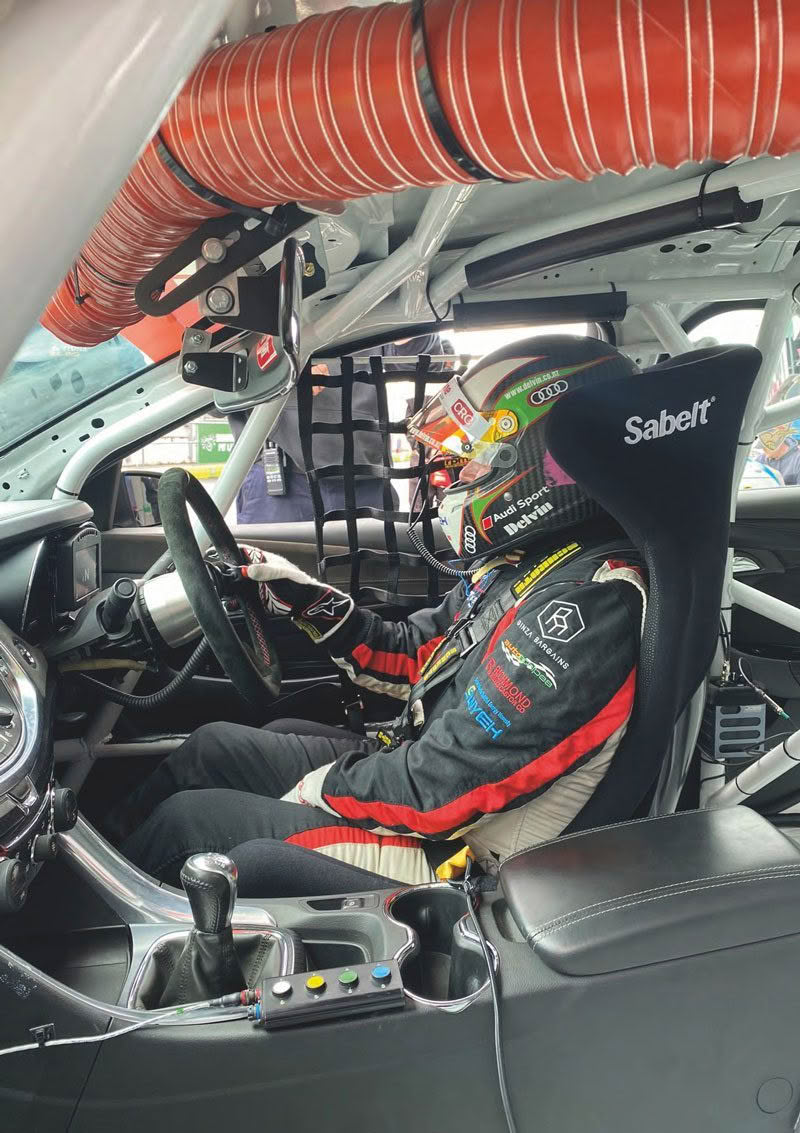
Through Karting, Brad had become a good mate of Earl Bamber. The drive came about through a mutual contact of the pair in Singapore, with the Kiwi invited to join a team for the 2020-21 Bathurst Six-Hour Production Car race. Sadly, COVID-19 intervened.
McDonald did, however, finally get his chance on Easter 2022 when the team finished fifth in their class in a Toyota 86.
With unfinished business on his mind, McDonald was disappointed when a rule change led to the team pulling out of the 2022-23 race.
However, he was put in touch with a team owner by the name of Trevor, and after a number of emails was contracted to drive a six-litre V8 VF Commodore in Class B, for normally aspirated high-performance vehicles. Apart from an enduro fuel tank, the car ran in standard trim on MRF tyres; the event tyre sponsor.
A couple of pre-event trips to Sydney then followed, firstly to be fitted out for the car, then for testing at Sydney Motorsport Park where the car ran flawlessly on Toyo tyres. He was part of a three-driver team with Australians Brent Edwards and Cody McKay.
Easter 2023 rolled around, and McDonald, his parents, and Vaughan from Pulse Performance in Whanganui headed for Bathurst. Vaughan became one of the heroes of the weekend, finding a rear-end issue with the car after practice which was affecting the car’s handling.

McDonald describes Bathurst as a “magical place” that commands respect and says that watching racing there doesn’t do the place justice. In particular, the drop-off from the top of the mountain has to be driven to be believed. He says there is a very fine line between going well and wrecking, and describes the speed down Conrod Straight as “amazing”.
Edwards qualified the Commodore, placing fourth in its class and 40th overall, before taking the opening three-hour stint as lead driver come race time. McDonald then did an hour and three-quarters, before McKay did the final run, bringing the car home at an impressive qualifying pace.
The Kiwi’s stint was largely uneventful, apart from the team’s sister car throwing a rod and dumping a load of oil on the track, nowhere near McDonald, thankfully. That led to fifteen minutes on pit road under red flag conditions, with the only work on the car permitted being a tyre change. When his drive ended, the Commodore was leading the B2 division and third overall in the B class.
As a Type 2 diabetic, keeping his blood sugar levels stable is essential, meaning McDonald was quick to rehydrate and have some food following his drive. He left his race suit on “just in case”, but McKay had no issues on the run home.
Well, almost no issues!
The safety car came out with three minutes remaining, and it looked as though the race would end behind the safety car. Race Control got the track cleared with great speed and called a one-lap dash to the chequered flag. That lap produced plenty of carnage, but most of it was further back in the pack.

Going out to the pit wall to cheer McKay to a class win was a highlight, but McDonald had a private dread of the podium ceremony in case he was asked to speak. Instead, the victory ceremony was a real thrill, with the team’s trophies being presented by Supercars legend Mark Skaife.
McDonald says he is unsure whether he will go back next year for a third crack at the Six-Hour. Part of him yearns to, but as a family man, he’s also concerned about the cost of at least three trips to Australia. There’s no prize money, and in Brad’s words, “We’re amateurs trying to be as professional as possible”.
There’s also the small matter of the speedway season. McDonald now owns Matt Buckley’s former Midget chassis (there’s a rumour that Peter Rees is building something a bit bigger than a Midget for Matt!) along with the motor out of Dylan Smith’s 1NZ car. Bob Smith and Laurie Mildenhall will be looking after the car and Brad is keen to step up and be competitive during the Minisprint championship season.
And the other guys and girls on the grid had better watch out; they have a Bathurst winner in their midst!
The Rotation System reviewed
With controversy appearing to surround the title rotation system, we took some questions to Speedway New Zealand President Ricky Boulton to see what he had to say.
“Championships have always been a difficult issue, and that’s why it’ll be a discussion at our next AGM in July,” he said. “Yes, there are flaws in any system when it comes to rotation, and it is on the agenda for discussion.
“There are some remits in there to fix a couple of minor things, but the reality is that’s what the clubs voted for, that’s what they want and it’s not up to Speedway New Zealand to dictate to clubs where championships should go. At the end of the day, we’re all one sport.”
Boulton notes the differing nature of eligibility criteria for each grade and class, recognising it as an important determinant to ensure that each host is deserving of their hosting rights.
“The criterion for every grade is different, some are four some are six contracted drivers to that club,” says Boulton. “You must have that many contracted drivers for that season. That’s number one.
“Number two is you have to supply a certain number of meetings. It may be four meetings in some grades and six in others.
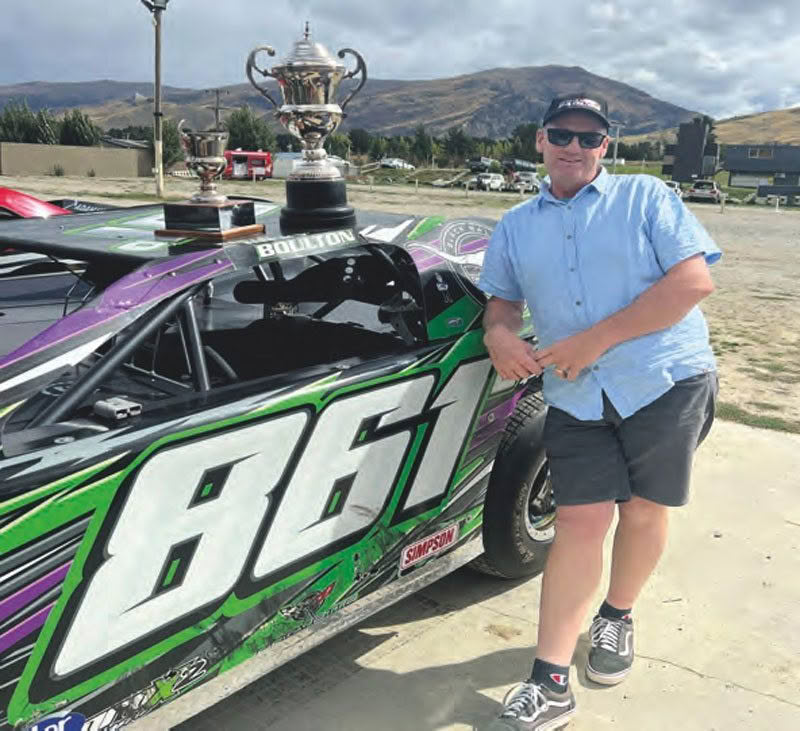
“So, the club has to run X amount of shows, with their X amount of contracted drivers and then you’re expected to have a certain number of visitors.
“Part of the criteria might be that the club you’re contracted to has to have six contracted drivers to be eligible. That’s tick number one. Six shows throughout the course of the season, that’s box number two, and X amount of visitors over a certain amount of shows. That’s box number three.
“As long as you’ve ticked those boxes as a club, then you’re eligible to be on the rotation as meeting the criteria for that particular championship of that particular grade.
“If you don’t tick one of those boxes then you fall off that criteria, and that’s to stop clubs that don’t put any particular effort into that particular grade.”
Boulton proceeds to note the congested nature of the calendar, noting Speedway is a summer sport with an extremely limited time frame to get racing in.
“We have 23 tracks nationwide and we have 15-18 grades which have four championships per year, being the NZ, the GPs, and the North Islands and the South Islands, so that’s 64 championships we run.
“All the promoters want to run those championships from about the 20th of December until the end of February, so that gives us nine weekends to run 64 championships. There’s going to be clashes.
“Our summers are short, and in different parts of the country, they’re even shorter. The past 12 months have been horrendous, also, with tracks all across the country suffering rainouts at various points throughout the year.”
 One area worth discussing was definitely the influence of rainouts, and whether or not they count towards the criteria which was decided on by the clubs and managed by Speedway New Zealand.
One area worth discussing was definitely the influence of rainouts, and whether or not they count towards the criteria which was decided on by the clubs and managed by Speedway New Zealand.
“Rainouts don’t count towards the meeting tally, and that is something we’re going to be discussing with the clubs at the AGM, it’s going to be a hot topic,” Boulton said.
“Obviously, that’s been worse this year from the horrific weather in the North Island, and that’s something we would have to look at on an individual basis. If those clubs wrote to us and said ‘hey, we’ve had nine rainouts out of 12 meetings’, then clearly they’ve had a shocking season.
“The problem is it’s having the amount of resources to be able to police it. Say, for instance, I’m a promoter and I put your Sprintcars on for six shows and I know that I’m struggling for numbers but I’m one or two shows outside the criteria, so I just cancel the meeting and say it’s due to weather.
“You can imagine on any given weekend, we have 23 tracks starting from Auckland down to Invercargill, it’s really difficult to keep up with it all. Sometimes they may blame track conditions due to the weather, so that’s why the criteria around rain offs is as it is at the moment.
“The sport’s not silly, we’ve done it all before with Covid and we’d obviously do it with weather as well. We’re not interested in penalising clubs, but what we are interested in is making sure clubs are making an effort to foster that particular grade that they’re wanting the championship for.” The Speedway New Zealand.
AGM will be held in Christchurch in late July. NZ Dirt Track Racing intends to be present for reporting purposes.
Broken cogs on Rotation System damaging NZ titles
The “Rotation System” is in desperate need of a good oil and grease with a few cogs needing to be replaced to make the system functional. The amount of ineligible tracks across several grades speaks volumes that the criteria are in need of a tweak or two.
This will allow tracks to get the best out of hosting NZ titles and not cause a reduction of numbers over grades which are limited to where they can run which becomes detrimental to the class. The flow-on effect of the loss of title-hosting eligibility includes the loss of drivers and cars at marginal tracks that have had a long history in the grade, simply because there’s no chance of having a home NZ title.
Minisprints are only just hanging on as a NZ title class, with just three tracks on the New Zealand rotation list. If one of those drops off, the grade is in trouble. The NZ Super Saloons are another with two tracks having to forfeit New Zealand titles, with the third under pressure but scraping in this season. Midgets were in the same boat, another high-profile grade struggling keep clubs on the rotation system.
The ever-decreasing number of tracks running titles does nothing to enhance growth and punishes struggling tracks, rather than supporting them. This could be the fatal blow that may see some clubs close in future years, with the lack of a club profile-boosting NZ title meeting forcing drivers and fans go elsewhere or be lost to Speedway in general.
The flow-on effect of dropping clubs has also upset the New Zealand titles line-up. Generally, both the NZ and Grand Prix titles are held on the same island, close to each other.
The first major example comes next season when the NZ Stockcar title was meant to run in Blenheim with the NZ GP held in Nelson. South Island clubs are known to work together to have the NZ titles back-to-back so North Island travellers can reduce costs to do both meetings in a manageable time frame, as well as halving ferry crossings and travel costs.
Blenheim lost the NZ Stockcar hosting rights which saw it allocated to the next track on the rotation, being Stratford in January. As a result, Nelson had to find something to help entice drivers across the Strait for a one-off GP meeting. History shows that one-off shows get far fewer entries from the North than joint title events. Nelson had originally opted to follow the South Island Title at Woodford Glen on February 16th and 17th, with the GP on the weekend following, creating an opportunity for a joint effort to attract cars across the Strait for both weekends.
The thorn that arose in this plan was that Waikaraka Park had submitted that the NZ Teams title was going to run the following weekend from the GP, in Auckland on March 1st and 2nd, the schedule then showed three of five SNZ Stockcar meetings running over a three-week period.
That would have meant that South Island teams had three huge weeks to fix cars between meetings, with three double-header weekends, plenty of travelling, and time required off work effectively meaning teams drivers from the North will not risk travelling South. Let’s not forget to mention what will happen if someone receives an 8-day, or even worse, a 21-day standdown during that period.
It instantly became a topic on Facebook when drivers worked out that the dates were going to be a nightmare. Woodford Glen already had the South Island date on their website, so Speedway NZ was copping abuse about how they allowed the conflict to happen.
The end result is that Nelson has opted to switch the dates so that the Grand Prix is now the weekend before the South Island title, creating a one-weekend gap between the South Island and NZ Teams title in Auckland.
Rotorua was also up in arms when - having already advertised a huge Charity Super Stock event - the GP was approved to run on the same dates. The Charity Show is a club event but is unlike other private promotions, having a strong public interest with famous personalities stacked throughout the line-ups.
If it was a promotion of Speedway outside of normal channels, then SNZ titles would get preference, but given the complexity of the charity event, an effort should have been made to avoid the clash. It’s going to be a tough choice for cars committed to the charity event to miss the GP, which could water down that title if some of the top names stay with their original plans to support Rotorua.
From this, we can say there appears to have been no correspondence between the host Stock car tracks as to when they were submitting their planned dates, other than Woodford Glen and Nelson, who were chin-wagging on a multitude of titles to fit both calendars.
The Nelson President mentioned in a recent chat with me that he had no idea when Stratford were planning the NZ title date, as each club submitted dates that suited them. As I understand no-one from SNZ messaged the clubs to say that these were possible dates for NZ titles, leaving clubs to talk to each other directly. It also appears that the dates are put forward and if there’s no major clash then they get approved.
Stockcar and Superstock titles can’t run on same weekend, with the same applying for Saloons and Super Saloons.
The line up of NZ and GP dates has generally been put on the same island, but now when a club gets pulled from the rotation it upsets the apple cart in future line-ups.
Perhaps the wise move is to make the title go to the next eligible track in the same island. This is especially more important for South Island title hosts to attract cars across the Strait, which in recent years has been a headache, with ferries disrupting the past two seasons with more issues on the horizon.
The rotation system affects the South Island more than the North as the Modifieds and Midgets are pretty much down to a single S.I. track to run all their SNZ titles. While they do run at other tracks, the numbers post-Covid haven’t met the threshold under current rules, having a huge impact on tracks who rely on South Island titles to attract visiting drivers and generate revenue. Without these titles their event are reduced to club meetings all season. When you’re struggling to attract drivers and fans, losing titles is just a kick in the guts.
The other issue down South is that Nelson, Woodford Glen and Ruapuna have a tennis match of South Island titles that bounce back and forth each year. Each of these clubs ends up with a multitude of S.I. titles in a season, with Woodford Glen having five South Island titles to fit in this year.
This was the problem that started with a consent issue in Nelson, when several titles needed to be run and the season was expanded, resulting in a resident complaint. The new consent limits the amount of two-day meetings the Nelson club can run per year. The T.Q. title will run with the Sunshine Sprintcar Classic over two days in December to preserve the two-day meetings that make the event attractive for punters to attend.
The removal of Greymouth from the T.Q. and Modified titles is a major setback for the club and the grades. They have had the minimum number of registered drivers but have failed to run enough meetings with weather and clashes affecting many meetings. The Modifieds have struggled on both sides of the Southern Alps this year. With Greymouth no longer on the SNZ title list, it means that Woodford Glen will struggle to attract North Islanders to one-off NZ or GP titles.
It’s always been a good system when Greymouth and the Glen followed each other when NZ and GP’s came South.
The T.Q.’s, which have had a big grown strongly in recent years, have frequently run in most Greymouth meets. While numbers have fluctuated, they have a core following from Ruapuna and Nelson who are the only other two tracks running them in the South Island.
It’s vital that Greymouth continue to be able to host the South Island titles at a minimum.
Nelson already has the NZ title, so the West Coast town would be a good place to hold the S.I. title, having lost the hosting rights to the GP which would have been a good boost for the club had it followed Nelson’s NZ title.
Leave the Stockcars, Superstocks, Streetstocks and Saloons rotation as is, they seem to be functioning ok, but if a host falls out then make its replacement come from the same island rather than the next in the queue. There needs to be flexibility in an ever-changing world.
The rotation system was put in ten years ago, and while some bits have run as required, it’s like a mobile phone.A ten-year-old phone may make calls and texts, but it’s outdated for modern day demands. The rotation system is falling short in today’s society as well.
It’s getting to the stage where some classes are only eligible to run titles at a only a third of the tracks in NZ despite racing on a large majority of tracks over the year. Sprintcars, Super Saloons, Midgets, and Modifieds are slowly losing coverage because of clubs not meeting outdated criteria, yet many of their members have been racing for decades but now won’t earn home titles.
One idea could be dropping the minimum meeting criteria and making a longevity rule to allow tracks to run NZ titles (eg 4 drivers that have been registered for 5 consecutive years). This would especially work in grades that are low in numbers, such as Super Saloons and Modifieds.
There will be many tracks that might struggle to meet criteria this year, with the likes of Kihikihi, Stratford, and Wellington all having been heavily affected by adverse weather. Some credit needs to be made when clubs have been unfairly affected by uncontrollable events.
Various series around the country have also influenced numbers at clubs, with drivers having had clashes on many home dates to travel for series meetings, meaning their home club missed vital meetings to meet criteria.
It’s in the club’s interest to allow drivers to travel to meaningful meetings, even if they are struggling to host the numbers on a regular race night.
A club may have four drivers yet fail to attract enough visitors to make a decent field. The Flynn brothers were a victim of this, while promoting the “Burger King Series” they were great ambassadors of the grade, but their dedication meant their home club Meeanee failed to host enough meetings to qualify for the NZ title. With all their hard work, the title should have come their way.
The Nelson Club are aiming to host the NZ Superstock title in 2025. Plans are underway to create a committee to start sorting sponsors, improving facilities, booking vendors, among more, but a lot of the confirmation is on hold until SNZ sign off hosting rights, which won’t happen until the club ticks off five more meetings next season that meet the criteria.
Covid and consent process had a major effect on the club, meaning they missed a year to meet the criteria. The pressure is on, but with a couple more cars coming out the plan is to knock the first five meetings off so that club can get on with the planning which will gives them just over 12 months. The club will need every minute once signed off.
If clubs have a link to the class, then it needs to be opened up to grow shrinking numbers and help gain interest rather than killing off classes.
The rotation system is now on its second five-year cycle and has developed broken cogs that will only create further issues if not addressed in the near future. It’s making the poor get poorer and the rich get richer.
Work with us, not against us - Speedway New Zealand President
There’s no doubt that Speedway in New Zealand continues to thrive in today’s environment, having survived recessions, pandemics, logistical issues, and weather-related disasters since it’s inception.
All of these are elements that are out of our control, but as time progresses through the digital age, we’re facing an even bigger threat: Ourselves.
Comments, abuse and general negativity towards the sport, its competitors, its board, and its volunteers continue to cause irreparable harm to something we all dearly love. But, quite simply, the negativity needs to stop before we drown in it, says Speedway New Zealand President Ricky Boulton.
“I am the first to admit, the sport is not perfect. As humans, we are constantly learning, changing, and finding new ways to do things better or more efficiently, whether that’s at home, at work, or in your workshop looking at your racecar – the strategic direction of the sport is the same. It’s constantly evolving to make sure we stay relevant to the present day”, says Boulton.
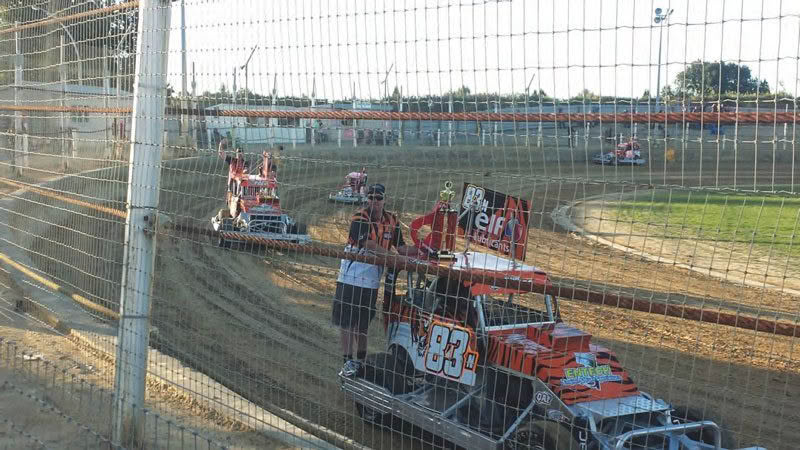
“But let’s talk about some facts: the sport is in great health. The season that we have just finished, 2022/23, has seen the sport as a whole grow by competitor numbers by just a bit under 10% to an overall record number of competitors ever. Just about every grade in the country grew by a double-digit percentage by competitor numbers. The sport is growing, we’re attracting new people to it. Let’s celebrate this.
“I raced at and attended a lot of meetings this season and saw, with my own eyes, people coming through the gates (when the weather allowed!) to see their heroes race at tracks around the country. I have heard stories from tracks up and down the country about the record crowds and the huge amounts of people coming through the gate for events from New Zealand titles to club nights.
“Let’s see the forest for the trees here – the sport is in great health competitor numbers-wise and people are flooding through the gates to watch, even during a cost of living crisis. These are not signs of a sport that is in bad health.”
Passion across any sporting arena is valued, showing that there is intense interest and people have a genuine excitement in the goings on. It’s when that passion turns into negativity that is becoming the problem, says Boulton.
“We all love this sport. We don’t spend hours in the shed during the week to go racing or hundreds of dollars to attend meetings because we just like the sport. It’s an easy sport to be passionate about too. It’s fast, it’s furious, it’s high adrenaline, it’s gladiatorial, and we all have a lot financially invested – I totally get it.
“It’s that passion that drove me to volunteer my time to the Board of Speedway New Zealand, I saw things I wanted to change or do better, so I became part of the solution, rather than complaining to my friends or on the internet, I did something about it.
“Now, not everyone is able to do that, I get that too. But the message that I want to get across to people is that there are ways to direct the passion you may have for an issue or for a change you may want to see in a more constructive way than being passive-aggressive online. In fact, Speedway New Zealand is one of the most accessible and transparent sporting management organisations in the country, we have so many channels and so many ways we welcome and are open to feedback and suggestions.
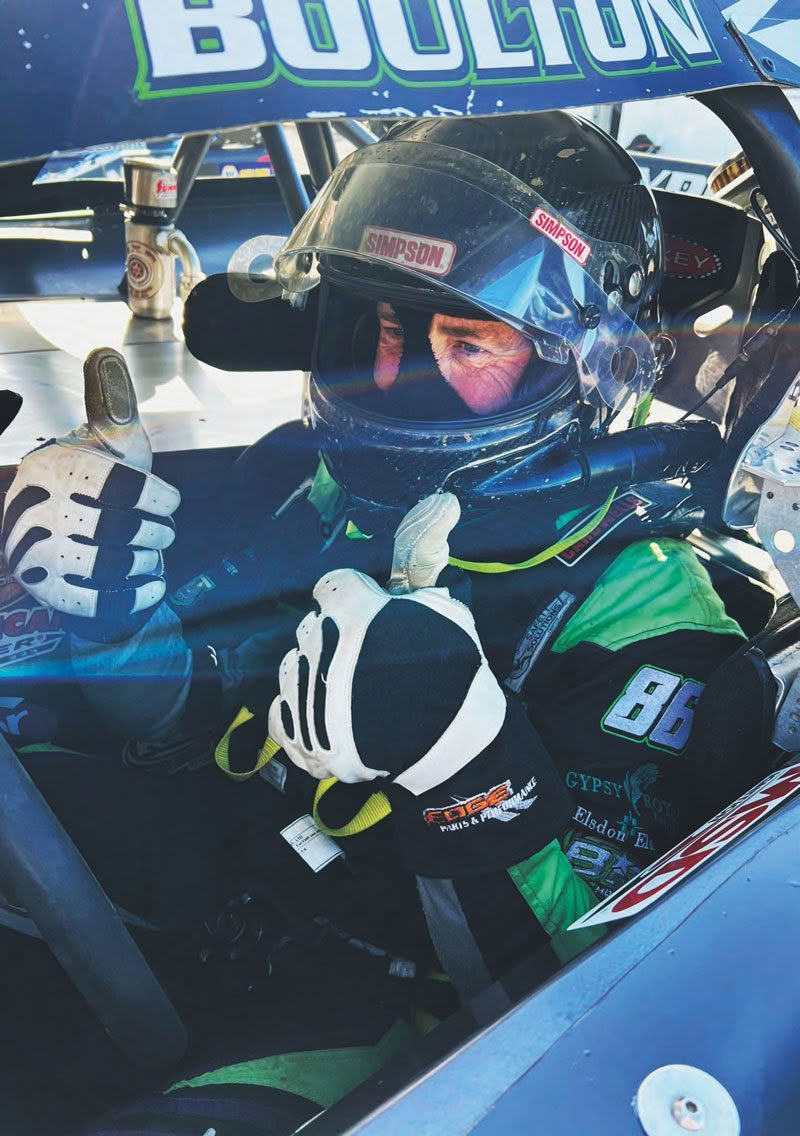
“I actually don’t accept that we don’t listen or care what people think or say about the sport. That is just flat-out wrong. It’s true that we are currently forming a plan to add even more channels to our communications bow, to make even more sure we can talk to everyone; whether it be podcasts, video updates, and more; the fact is that we engage with our members on most of the changes that effect them. There are still many, many ways to get in touch with us so people can tell us their views.
“We go out to members when we change technical rules, racing rules, or constitutional changes. And when we do put out communications, they go on our website, our newsletters, social media of our own, or our app that allows us to communicate with competitors. If all else fails, we have a full-time staff in the office who are reachable and able to answer any questions or concerns that people may have.
People needed to realise, Boulton says, that there is very real damage that can be done to people when they are attacked verbally or in writing, in person and online. Boulton wanted to get the message across to everyone involved in Speedway to remember this before taking their frustrations online or in person at the track.
“I just want people to treat people how they want to be treated. If you’re online, think about whether you’d say this to someone’s face. If the answer is no, then don’t say it. If you’re at the track, think twice about the reason something might be the way it is before swearing at or abusing someone. I think 90 per cent of the sport’s negativity would stop if people thought about it and found out why the rules are the way they are.
“All of our people are volunteers. They are people. They have families and friends. They are also passionate about the sport, that’s why they’ve chosen to become volunteer officials, administrators, board members, committee members, or promoters. They’re ultimately there to facilitate the show and make sure that everything is fair and safe for everyone.
“We’ve lost a lot of good people in my time as a competitor, board member, and now president. That ranges from senior stewards, referees, track staff, to paid people in our office. People make the sport tick. If we lose everyone, then we can’t do it. It’s as simple as that.”
Boulton says that significant investment has gone into the Speedway New Zealand website to make it as user-friendly as possible, with a complete rule book easily found on the home page.

“People need to use our website. Speedway New Zealand’s website is an absolute wealth of information. Our full rulebook is on there, with information about officials, how to become an official, information on championships, what the championships are, and what the dates of the championships are. Everything is on our website, and not enough people use it.”
It’s a relatively tricky topic to approach, but it needs to be brought to light. We have a sport to be proud of, and we should all be lauded for what we’ve accomplished over the past few years.
“We’ve got record numbers. We’ve got record champions. We’ve got some of the best drivers in the world involved with Speedway. It’s a sport to be absolutely celebrated. It’s something sponsors want to be involved with because it has such good coverage.”
Words from NZ Dirt Track Racing Magazine
NZ Dirt Track Racing Magazine is committed to the betterment of our sport and will continue to work to protect its integrity through our publications and Social Media pages.
We challenge others to do the same.
When God raced in paradise
In many ways, the racing appearances of legendary American racer AJ Foyt in New Zealand signalled the undeniable possibilities that were sitting waiting for midget car racing in New Zealand. Still, it’s a piece of history rapidly slipping into the sport’s folklore.
It all came at a time when motorsport was riding the crest of a wave, with the annual Tasman Series for Formula 5000’s commanding a considerable amount of ink, not only in trade I magazines but also in the daily papers, radio stations and television channels, who all clamoured for a ‘scoop’.
There were often stories circulating that world-class drivers like Mario Andretti and Al Unser were on the cusp of being signed up for the Tasman Series, and let’s be honest- that well-healed circuit was undoubtedly in a position to get the signatures on the dotted line.
Quietly in the background, the trio of George Tervit, Gary Roberts and Tony Leader, promoters at Western Springs, were hatching a plan- to get the legendary American AJ Foyt to New Zealand and Australia to race Midget cars.
Known affectionately as ‘The Three Stooges’, Tervit, Roberts and Leader transformed Western Springs in a promotional sense, forever changing the landscape of our sport.
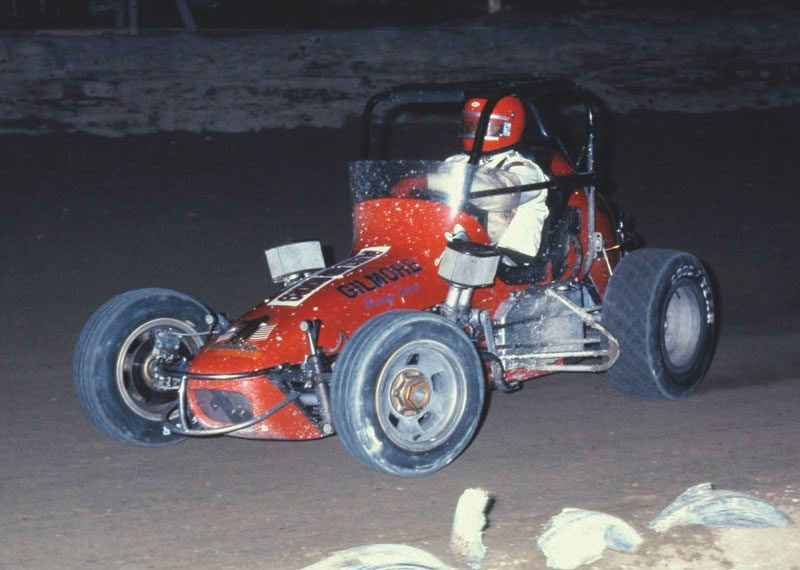
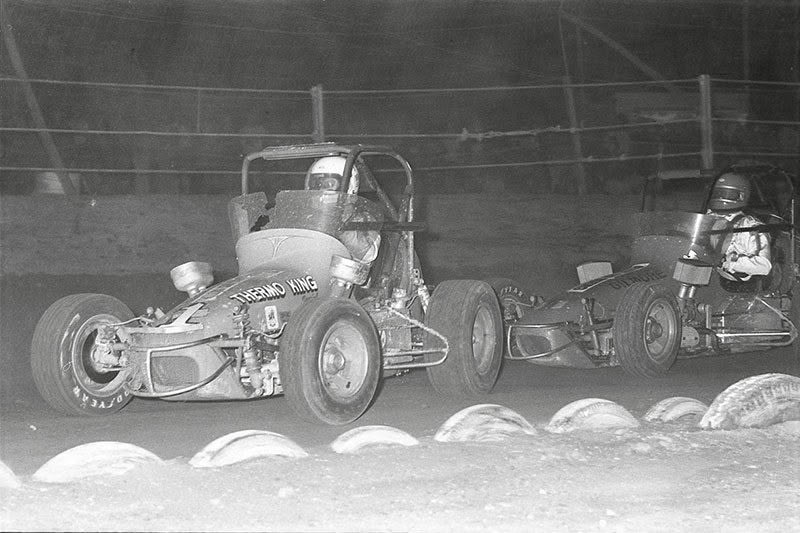
They aimed high but knew the untapped potential of the corporate world needed to be sold on Speedway racing but, based on what had been presented in previous years, knew it needed to be big.
With all due respect, drivers like Bob Tattersall, Merle Bettenhausen and Dave Strickland were big names in the Speedway world but were barely known in the outside world.
For many years the sport had piggybacked off the ‘Ronnie Moore-Barry Briggs-Ivan Mauger’ global domination of motorcycle speedway, and the likes of Barry Butterworth, Ian Holden and Trevor Morris were more likely to be on the tongues of the patrons at Ponsonby’s legendary ‘Gluepot’ than the Queen Street ivory towers, but Foyt was a global motorsport phenomenon.
Tervit, who was at the centre of the negotiations, knew he needed allies, and he used American Midgeteer Mel Kenyon, who had raced at the Springs several times to ‘open the door’.
When I spoke to George [Tervit] in 2017 about ‘the Foyt deal,’ it was clear that it was risky, expensive, and logistically challenging but worth taking.
“I took the possibility of luring Foyt to New Zealand and Australia to the annual Australasian Speedway Promoters Conference,” Tervit said. “When costings were discussed, all but Mike Raymond (promoter at Sydney’s Liverpool Speedway) considered it a ‘financially unviable’ proposition, so it was left to us to carry the can.”
A potential sticking point was that Foyt wasn’t prepared to drive a local car, so Mel Kenyon and his brother Don promised to assemble a brand spanking new machine for Foyt to use, and they would ship it down under from their Lebanon, Indiana headquarters.
At one point, news filtered through from the USA that Foyt may have changed his mind, but Raymond replied, “I don’t care what he costs. Our reputation as promoters is on the line. AJ will be racing in Australia this summer.”
And he did!
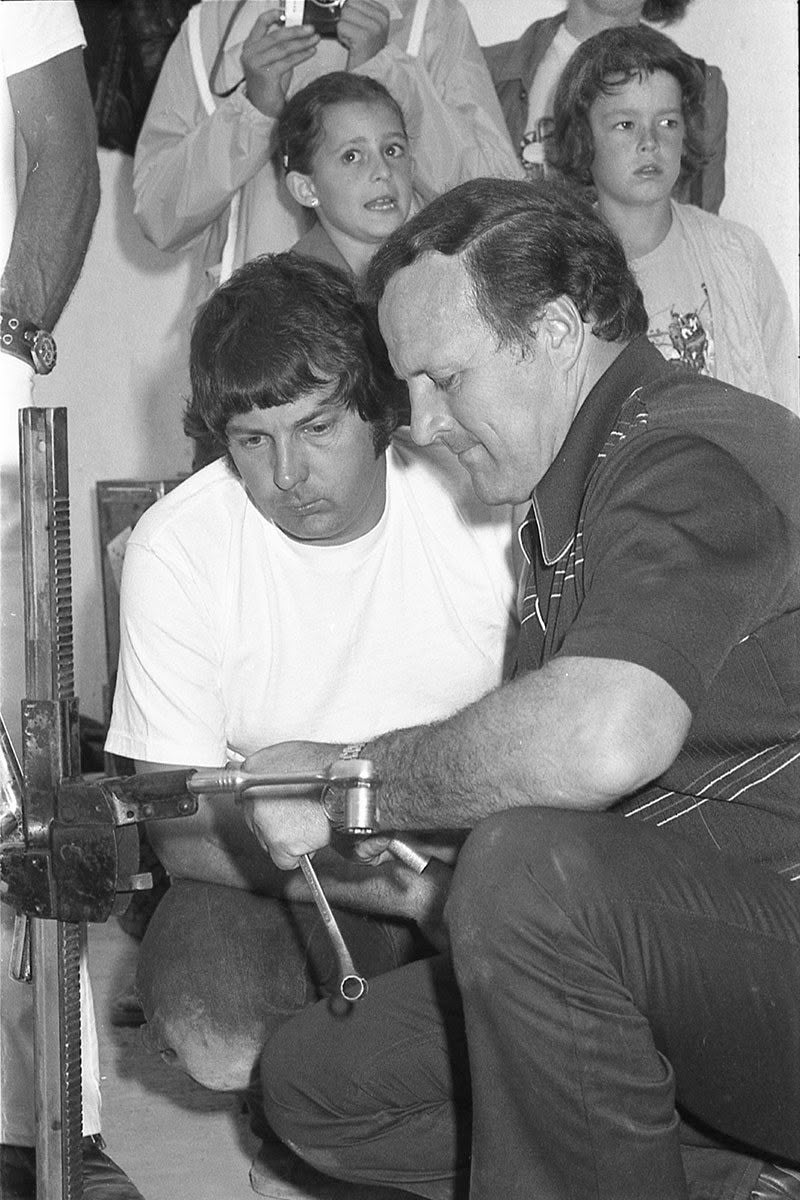
After much trepidation and more than a touch of anxiety, AJ Foyt - at that time a three-time Indianapolis 500 winner, Daytona 500 winner and a 24 Hours of Le Mans winner - arrived in New Zealand with his entourage which included his IndyCar sponsors Jim and Di Gilmore.
The country’s news media lauded the arrival of the motor racing great, but Foyt was more interested in getting out to Western Springs to run the car.
There was plenty of anticipation, but it was put on hold when heavy rain saw Foyt’s first appearance take a 24-hour rain check. Despite the sodden track and grounds, a big crowd poured through the gates to witness history in the making- one of the world’s true motorsport stars was racing Speedway in New Zealand.
It wasn’t a perfect start, with Foyt finishing third in a heat race and fourth in the Bob Tattersall Memorial. He told reporters after the race, “We will have to get the car right for Saturday. I’m not used to running fourth.”
Some social engagements were cancelled so that Foyt and his team could put in some hard yards, and they found a significant issue when they found that a lobe had broken off the cam. A big job faced them with another appearance at the Springs the next night, followed by a quick trip across the Tasman to race at Liverpool.
Tervit and co were undoubtedly getting desperate when their next race got washed out, so it was out to Auckland Airport early on Sunday morning, where they loaded the cars and personnel on a flight to Sydney to race later that day on the pavement at Liverpool.
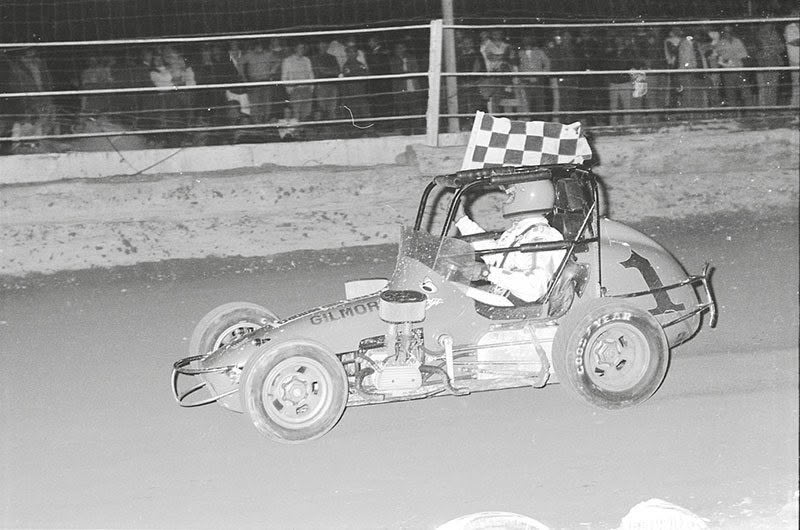
Mike Raymond remembered the chaotic schedule. “The first night at Western Springs (Wednesday) was washed out, so they raced Thursday. The Springs were supposed to run on the Saturday, but it rained again.
The cars were freighted across the Tasman to Liverpool to race Sunday, back to Auckland to race Monday and then down to Christchurch to race Tuesday.”
Added into the equation was that the car had to be reconfigured from dirt to pavement and back again.
Liverpool proved to be more up Foyt’s alley, and after finding some form in the heat races, Foyt and Kenyon started off the back row for the 40 Lap Australian Grand Prix. By the second lap, they were in the lead with Kenyon in front.
They were lapping the traffic by the seventh lap as they put on a real show. On the penultimate lap, Kenyon made the smallest of mistakes and clobbered the wall, putting Foyt into the lead and headed into victory lane.
There was little time for celebration and plenty of work to do in the next twenty hours. Kenyon’s car required straightening after he had hit the wall in the latter stages of the Liverpool race. There was also the small matter of the vehicles being cleaned before being flown back across the Tasman to Auckland for the rescheduled race.
Back at the Springs and AJ showed that he was ‘back in the seat’ as far as Midget car racing was going, following up on his Liverpool win by putting up a great display of racing in his opening race at the Springs, blasting from grid twelve to hit the front after only five laps, before taking the win over Australian Johnny Fenton with Kenyon third.
The feature event was the World 30 Lap Championship, and the two Americans had another back-of-the-field start.
It wasn’t long before they had carved their way through the traffic. Kenyon started to dominate as the laps went on, but the key battle was for the minor money where Australian Barry Pinchbeck, in an Offenhauser, and AJ were having a right royal go at each other. Every move by Foyt was countered by the Aussie, leaving AJ having to be content with third place, heading off Fenton and hometown heroes Trevor Morris and Barry Butterworth.
The following day, Australians Barry Pinchbeck and John Fenton joined Foyt and Kenyon on a trip south to race at Christchurch.
The hectic schedule began to take its toll on the travelling contingent, with most battling colds and tiredness. If ever tempers were going to fray, this was the night as AJ’s racing commitments in Australasia came to an end.
In some respects, it was also ‘save the worst for last’ and, although AJ’s only appearance in the South Island was one of historical significance, it was barely memorable for the quality of the racing. None of that can be laid at the feet of the drivers.
The quality of the drivers on hand deserved better, best summed up by AJ, who said, “I’ve raced on some slick tracks in my time but nothing as slick as this.”
Not only was the track hard and dry but there was an unhealthily thick coating of crusher dust, causing the cars to constantly wheel spin and go nowhere fast. Added to this was an electrical fault that invaded the starting lights and long delays in getting the fields lined up. It’s little wonder that there was a great relief to all that the tour was over– even if it took local officials until 11.30 PM to get the racing in.
AJ won one of the team races and then gathered up a couple of second placings before winning the feature race, which was shortened to just eight laps.
Foyt had to be back in the United States for tyre testing, and one can safely say that they all slept well on the plane trip home.
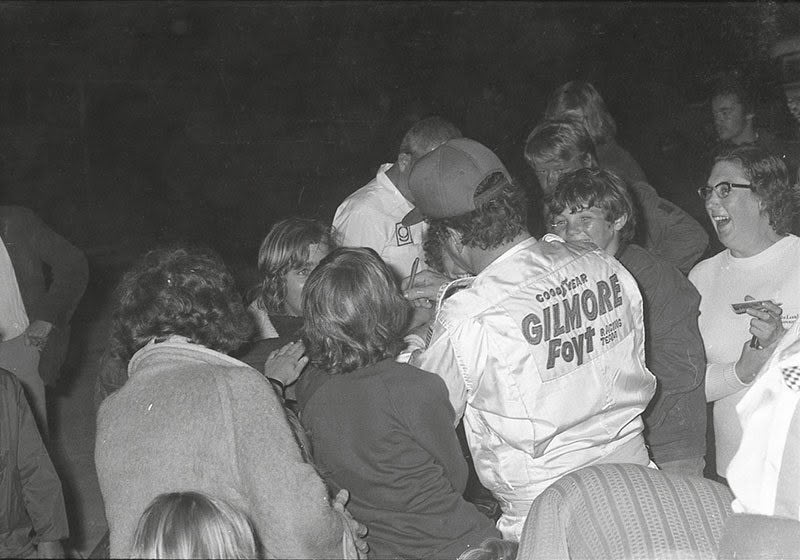
Despite the schedule, Foyt agreed to return ‘Down Under’ the following year if he could get a few days off to relax.
The tour would start this time in Australia, and Foyt travelled south with his good mate and fellow IndyCar legend George Snider who was travelling as ‘Car Owner’.
The rugged Texan again underlined his liking for the Liverpool pavement, carving up the field to win the Australian Grand Prix, lapping all but the second and third-place getters.
Foyt then made it two feature wins from two with another dominant performance on a trip up the road to race at the Brisbane Exhibition a couple of nights later.
There was a bit of breathing space with his first appearance at Western Springs for this campaign being four nights later, where he would be well tested by the formidable Kiwi contingent, as well as fellow Americans Mel Kenyon, Larry Rice and Gary Patterson and the highly rated Aussie pairing of Tony De Rosa and Johnny Fenton.
The night did not get off to a great start when, going into the first bend of a match race against Tony De Rosa and Kiwi Ted Tracey, all three cars locked together.
AJ’s VW spun onto the infield and sustained damage to the fuel injection unit. A rushed trip for a crew member to pick up a replacement unit and the subsequent repairs saw AJ sitting out of Race 2.
He re-joined the action for the third and final heat of the Champion of Champions series. From grid one, AJ was never headed. He certainly made up for lost time, knocking two seconds off Kenyon’s ten-lap record.
The final race of the night was the 20- lap Bob Tattersall Memorial. Foyt started off the back grid in fourteenth and, at the halfway mark, had made good progress and was making his way through traffic.
Suddenly a gap that had been opened closed, and AJ collided with local driver Dave Jolly, rolling three times as a result. His car came to rest minus a wheel, but that was small fry compared to Foyt, who emerged from the carnage shaken and stirred. The crash crew had to restrain him as he looked around for a chance to have a word with Jolly- and maybe settle the score.
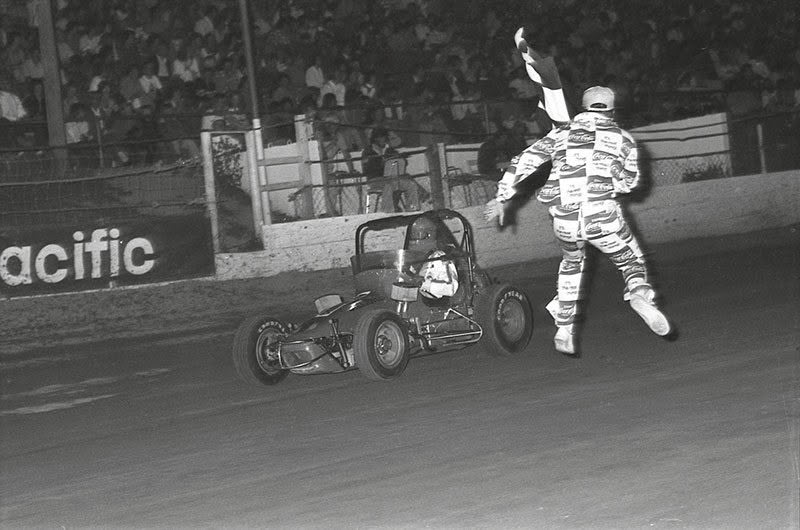
George Tervit remembered that despite Foyt’s ‘legendary’ temper, this was the only time that AJ nearly lost his cool on the two tours.
“AJ wasn’t at all happy. He certainly wasn’t used to getting put upside down.”
If there was one massive improvement on the previous tour, it was that the Foyt contingent had time to have a look around and have some fun.
Some of the pranks attained legendary status.
One involves AJ driving around Auckland at night, turning the ignition key on and off in his rental car to produce loud backfiring. Apparently, he couldn’t register how New Zealand appeared to close down at sunset.
The tour continued two nights later at the Te Marua Speedway near the nation’s capital, Wellington. The track was known more for its Stock Car racing, and it may have been the first time that AJ had raced at a track surrounded by logs as a safety fence.
A big crowd was on hand to witness the most significant ‘open wheel’ event in the track’s history, and there’s no doubt AJ would have been keen to get his tour back on track.
In his first race– a heat of the International Trophy Dash series- he won easily, heading Australian Tony De Rosa and Christchurch’s Laurie Millar home.
AJ’s lap time of 18.1 was a new record, but he blew that out the window when he won the Dash Final against Americans Gary Patterson and Mel Kenyon setting a new standard of 17 seconds flat.
He continued his winning ways by taking out the first heat of the Champion of Champions in a new ten-lap record time.
Fourth place was as good as it got in the second heat, but going into the final, he was just one point behind Kenyon. AJ was after another trophy and followed Australian Johnny Fenton through the traffic to sit in second by the end of the first lap. For nine laps, the order was Fenton, Foyt, Kenyon and Patterson, but on the last lap, Fenton drifted wide. AJ was through like a flash but was tagged by Patterson, who was hard on AJ’s tail. Foyt’s race was done, and he had to watch the finish from the infield.
The entourage was all set to fly back to Auckland the following day to race at Western Springs; however, with poor weather in the capital, the decision was made to drive.
This was the catalyst for a much talked about (in speedway circles) journey where a rental car was summonsed, and AJ drove Patterson and Rice back for the ten-hour trip…...it took six hours.
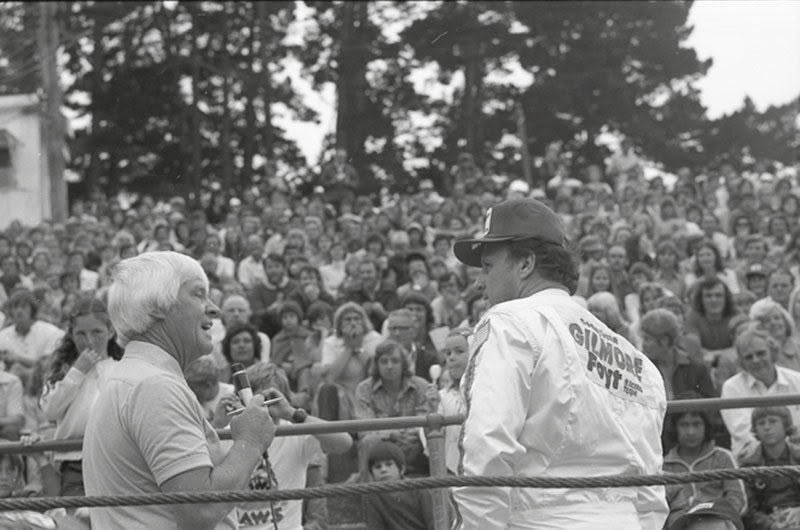
Whilst the fun-loving Patterson loved every second of the trip, Rice sat in the back seat with his eyes closed, convincing himself that the world’s most famous race car driver was at the wheel as the rental slid sideways around many corners on that long, twisting road.
The drive and its hair-raising moments were all for naught, with the Springs washed out the next two nights.
With poor weather on the horizon, a hastily arranged race at Palmerston North was organised. So, it was back down the island to Palmy, where another big crowd rolled through the turnstiles.
In association with George Tervit, Promoter Ray New had enticed Foyt, Mel Kenyon, Larry Rice, Gary Patterson and Aussies John Fenton and Tony De Rosa down to Palmerston North, and the racers responded with a great showing.
AJ bagged one win from the three races and left the crowd with no illusions about his legendary status.
He also weighed into a local issue when told that the speedway was under threat from noise complaints, telling a reporter from the Evening Standard that the ‘oval’ was one of the finest he had raced on.
“It’s ninety per cent better than all the quarter-mile tracks back home. It is something that the city really should be proud of!”
With that, it was back on the road to Auckland for the final race of his tour, but again rain intervened, and after two further rainouts, Foyt headed home, away from what was at that time Auckland’s wettest January since records had started in 1852.
It was a soggy end to what had been an amazingly brazen venture.
While it hadn’t provided a financial windfall at the ticket box for George Tervit and his partners Tony Leader and Gary Roberts, Tervit said the lift in profile for their track was a far greater return.
“It opened the corporate doors for us. Air New Zealand were so impressed that they agreed to fly drivers from the USA to New Zealand, along with their cars, for next to nothing, provided that driver had raced in the Indy 500.”
Another upshot is that many New Zealand and Australian race fans can say hand on heart that they had seen the legendary AJ Foyt racing in a Midget car.
Close on fifty years later, you have to respect the effort of promoters George Tervit, Gary Roberts and Tony Leader from Western Springs and Liverpool’s Mike Raymond, who collectively oversaw the mind-boggling logistical minefield in moving cars, drivers and crews from Auckland to Sydney, back to Auckland and then to Christchurch over the course of six days.
It’s little wonder that all these years later, they are still considered among the finest promoters the sport has seen.


